News
News
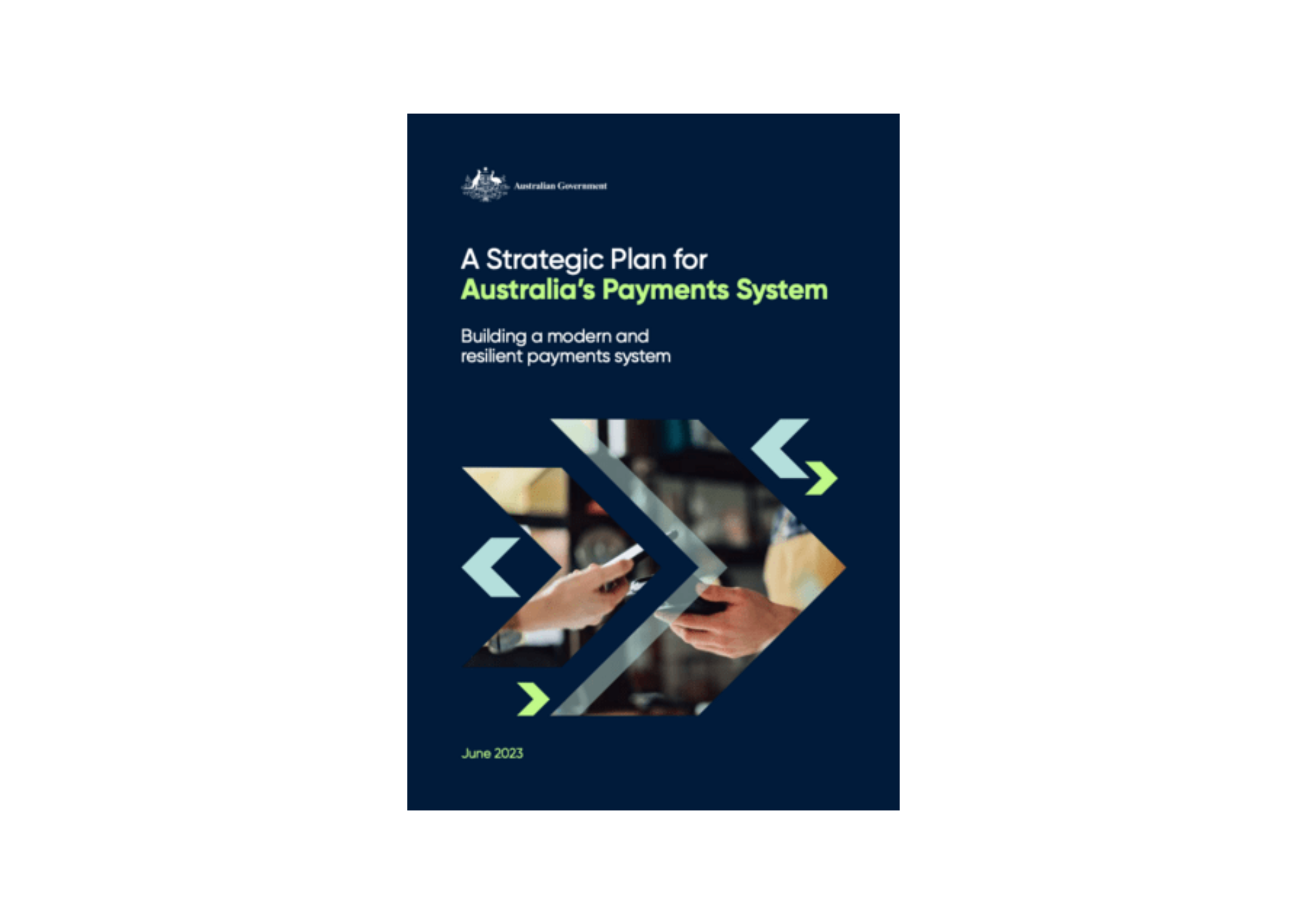
A Strategic Plan for Australia’s Payments System
The Government is releasing its Strategic Plan for the future of Australia’s payments system which sets out its policy objectives and priorities for the payments system.
The Strategic Plan was developed through a consultation process in collaboration with regulators, industry, consumer and business representatives.
The Strategic Plan provides businesses with certainty and clarity on the Government’s approach to important issues in the payments system, allowing businesses to invest with certainty and innovate. The Strategic Plan also outlines the Government’s commitment to ensuring that Australia’s payments system is safe, affordable, can be trusted and will remain readily accessible.
The Strategic Plan will be reviewed on an 18 month review cycle. This will allow the Government to report on its progress against its objectives and priorities, and ensure the Strategic Plan is responsive to advances in technology, competition and changes in consumer demand.
Source: treasury.gov.au/

From days to minutes: Payment services provider Indue accelerates its ability to innovate using Azure
Indue has been a significant player in Australia’s payments sector for more than 50 years. The payments technology provider is an Authorised Deposit Taking institution who specialises in helping organisations of all types adapt to and benefit from the latest innovations in payments technology.
Through its solutions – which encompasses everything from card management and mobile payments to direct entry transactions and real-time fraud detection – Indue aims to eliminate the need for multiple third-party engagements and streamline the payment system implementation process.
Indue is a founding member of Australia’s New Payments Platform (NPP), launched in February 2018 to modernise the nation’s payment infrastructure. The platform enables faster, more flexible and data-rich transactions to meet the evolving needs of Australian consumers, businesses and financial institutions.
Keith Bromwich, Head of Architecture at Indue, says Indue has helped clients adopt the NPP since its inception.

“Our role is to allow tier 2 and 3 financial institutions such as mutuals, regional banks and BAAS providers to access the NPP via our own platform,” he explains.
In June 2023, the NPP introduced PayTo, a new digital way for merchants and businesses to initiate real-time payments from their customers’ bank accounts. PayTo solves many existing challenges with direct debit payments, including processing delays, limited transaction information, and a lack of control for consumers and businesses over payments.
To ensure it could help clients adopt the new payment method, Indue embarked on an ambitious project in March 2022 to transform its technology infrastructure – largely made up of on-premise data centres – and adopt a more cloud-native approach.

In May 2022, Indue engaged Microsoft partner Arinco to help it develop enterprise-scale landing zones and a robust application programming interface (API) platform in Azure.
“The people we worked with at Arinco were absolute knowledge leaders,” says Bromwich. “They helped us make the right decisions by providing the pros and cons.”
Arinco used a flexible delivery approach to facilitate development timelines, which saw the first application landing zones for PayTo being implemented by early July 2022. This enabled Indue’s developers to build new capabilities for testing by October 2022.
As this was Indue’s first major deployment of modern web APIs in Azure, Arinco supported and educated Indue’s developers and engineers by leveraging its partnership with Microsoft.
“Firstly, we embedded consultants within Indue’s development teams, focusing on accelerating outcomes and providing best practice guidance for topics such as .NET development, Azure API deployment and security,” says James Westall, Account Executive at Arinco.
“Secondly, our consultants worked with Indue’s platform engineers, sharing our expertise with them as we developed code for each landing zone. This meant that at transition time, Indue engineers were starting from a solid knowledge base.
“Lastly, we partnered with Microsoft to deliver hands-on Azure Accelerate workshops. These covered key topics identified by Indue, enabling employees to get familiar with Azure in a safe environment with instructor guidance.”
The other challenge that Arinco helped Indue solve was the operational sign-off of its Azure capability.
“As an entity that’s regulated by the Australian Prudential Regulation Authority, Indue must be able to attest to the security, stability and robustness of its services,” explains Westall. “The deployment that we developed was designed to remain compliant using Azure and third-party security tools, including the capability to hold Payment Card Industry data.
“We also assisted Indue in developing several operational documents and procedures, ensuring key details about running solutions on Azure were available for external auditors.”
Arinco’s accelerated approach enabled Indue to launch its PayTo integration within the tight timeframe and begin onboarding clients in June 2023.
Enhancing innovation in the cloud
While Indue is still in the early stages of its cloud journey, its event-driven architecture in Azure is already delivering benefits. These include increased flexibility and scalability, which enable Indue’s developers and engineers to deploy any project – not just PayTo – in the cloud much faster and move from business idea to development workload in minutes or hours rather than days.

“The innovation piece is a key focus for Indue and its customers,” says Ryan Spain, Chief Information Officer at Indue. “Leveraging cloud-based technologies like Azure gives us access to a much wider variety of innovative capabilities in a fraction of the time compared to on-premise, and enhances the products and services we can offer.”
Indue’s move to the cloud has also helped them simplify its technology stack and reduce operational costs. Transitioning its Corporate Services (Virtual Desktop, remote access, and Office environment) to the Azure Virtual Desktop capability which operates within the enterprise-scale landing zone structure.
Now, key personnel can focus more on value-adding tasks rather than maintaining the performance and security of Indue’s hardware and software.
“We don’t have to worry about data centre connectivity or patching. All of that low-level maintenance is done by Microsoft,” says Bromwich.
Indue plans to grow its cloud footprint in Azure by kicking off two other major projects in 2023. One will focus on implementing a big data lake that leverages Microsoft’s advanced analytics capabilities. The other project will focus on migrating Indue’s on-premise Microsoft Dynamics 365 platform to Azure. Both projects will further enhance Indues’ ability to deliver innovative payment solutions and a better customer experience, according to Spain.
“This is a strategic partnership with Microsoft,” he says. “They’ve been on the journey with us from the start, and we really appreciate the assistance and guidance they’ve provided. The partnership has been a key enabler for facilitating both the PayTo integration and our broader cloud strategy.”
Source: Microsoft News 30 June 2023

We’ve launched our PayTo service offering
Indue is excited to announce the official launch of its PayTo service offering, enabling financial institutions and payment service providers and platforms to drive payment innovation and improved customer experiences.
A development of Australian Payments Plus on it’s New Payments Platform (NPP), PayTo modernises the way bank accounts are used for payments, helping businesses and consumers thrive in the digital economy.
Indue CEO Derek Weatherley said the PayTo launch is a natural extension of Indue’s NPP capability, which has been helping Australia’s leading mutual and community banks take advantage of flexible, real-time payments with industry-leading financial crime support since 2018.
“At Indue, we are committed to investing in product technology advancements that support our client’s digital transformation, innovation, and competitiveness, exemplified now through PayTo,” Mr Weatherley said.
“We have a team of NPP experts that have already begun to connect partners to PayTo, delivering them a faster, simpler, and smarter real-time payment service.
“We are thrilled to be part of the PayTo revolution and, as always, are keen to help our current and future customers keep pace with the changing Australian payments landscape.
“PayTo will enable a superior payment experience by streamlining payments and improving efficiency and control for consumers and businesses. This is achieved by PayTo while at the same time reducing risks and modernising the way money moves.
“Ultimately, PayTo further enhances Indue’s digital banking offering, providing a state-of-the-art payment services experience for our customers.”
Indue can connect financial institutions, payment service providers and platforms to PayTo .
To learn more and get PayTo ready, click here.

The Mutual Bank Partnership
For 135 years, The Mutual Bank has met the financial needs of the Maitland, Newcastle, and Hunter communities in New South Wales, serving and supporting them in building a sustainable future.
Since March 2022, Indue has provided The Mutual Bank and its members with a significantly expanded payment services suite, including Direct Entry, BPAY, NPP, Financial Crimes, Anti-money laundering, Card Services, High Value Payments, and an expansion of its Digital Payments offering.
The Mutual Bank CEO Geoff Seccombe said the partnership continues to be driven by a strong alignment in company values, product offerings, and payment needs.
“Our relationship with Indue began when we needed assistance in becoming the first local mutual bank issuer of Apple Pay in the region. But it is founded upon much more than a vested interest in innovative payments technology,” Mr Seccombe said.
“Indue earned our trust, respect, and business by delivering on its payment services promise, and it has kept it by continuing to share our community-first focus and partnership culture.
“I commend Indue for its support of the local communities in which we operate, and its unwavering commitment to environmental, social, and cultural initiatives,” Mr Seccombe said.
Indue CEO Derek Weatherley said that alignment with our clients’ sustainability practices, community programs, and employee wellbeing are core to our values.
“The best partnerships are achieved when company culture and core values align, which is what we have experienced with The Mutual Bank,” Mr Weatherley said.
“We have an excellent understanding of The Mutual Bank’s priorities and their wider community goals in operating in a socially responsible manner, prioritising positive social impact and a genuine ‘one team’ support model with on-the-ground support.
“We look forward to continuing to work with The Mutual Bank and its community” Mr Weatherley said.

Indue Upgrades High Value Payment Processing Capability
21st March, 2023
Indue is excited to welcome in the next era of high value payments processing, as the industry reached a significant milestone this week with a major multi-year upgrade to ISO20022 messaging standards, to future-proof the payments system and enable domestic and international payment system interoperability and data-rich messaging.
In conjunction with the rollout of this major industry upgrade, Indue has enhanced its high value payment processing technologies to maximise the operational efficiencies and security posture of the system.
Indue Chief Executive Officer Derek Weatherley said these new messaging standards will bring many benefits for customers and their operational staff, such as improved financial crime monitoring, rich data and international harmonisation via the SWIFT network.
“We have kept clients front of mind while redeveloping our high-value payment processing capabilities to ensure they capitalise on the value of the technology,” Mr Weatherley said.
“Among many benefits, our clients will have access to streamlined end-to-end processing and full self-service capabilities through the online portal that enables real-time transaction tracking, approval and auditing.
“The upgrades also support API messaging for updates, notifications and other functions, automated approval processes, significantly lowering operating costs and risks, as well as modernising the overall security posture, including multi factor authentication.
“Our processing capabilities align with the ISO20022 upgrades to ensure our clients can enjoy greater operational efficiencies, and we look forward to driving faster payment experiences with the roll-out of these technologies.”
The upgrade was launched with Auswide Bank in March 2023, with an iterative roll-out across our full client base underway.

NPP Roadmap provides update on the platform’s uptake and capability development
The NPP October 2022 Roadmap has been published.
An update on the NPP roadmap is now available providing the latest numbers relating to the growing use of the NPP. There are now close to 89 million accounts able to make or receive NPP payments and the platform now processes more than 100 million transactions a month. One in three of all account-to-account credit transfers are occurring via the NPP. There are close to 13 million registered PayIDs, a 44 per cent increase since the same time last year with 315,000 new PayID registrations on average being added every month. Usage of PayID is growing with research conducted by NPP Australia revealing that 47% of users using PayID at least weekly.
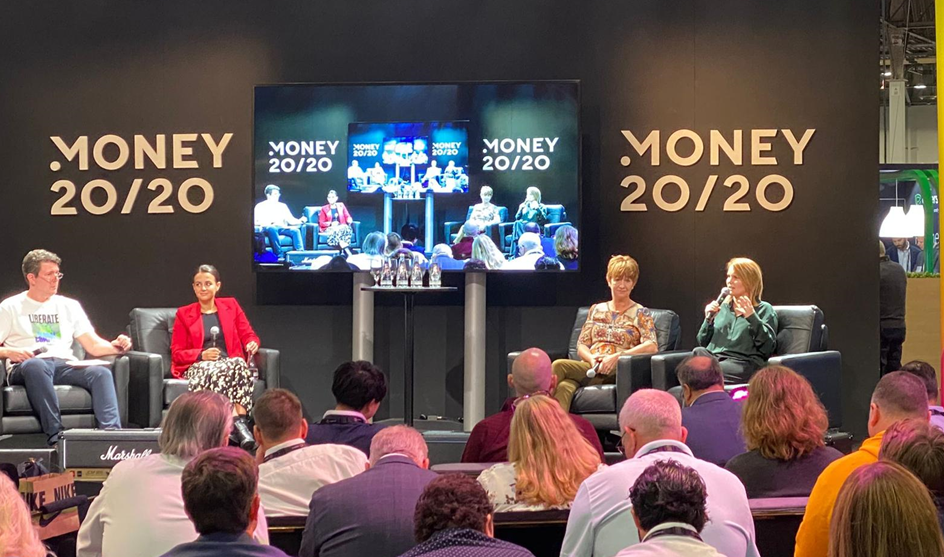
ID8 Tour | Money 20/20 – Blockchain & Crypto
Blockchain and
crypto have made a surprising resurgence to the agenda at Money 20/20, likely
driven by the growth in central bank currency pilots and collaborations into potential
use cases for government issued digital currency. The Indue client tour
participants absorbed broad learnings on how the concept of a fully digital
decentralised network could benefit customers and clients in the payments and
banking sectors.
A wide spread of
blockchain use cases were presented, everything from connected cars through to
micro payments, with the major feature being the ability to move money in
real-time at lower cost, a presumption that we see either prove or disprove
itself in the years to come.
The focus on the
use of crypto in payments has been heavily on enabling cross-border
transactions, as well as the challenges posed by increasing regulation.
The bold headline
from proponents of the technology at Money 20/20 was that everything will be on
blockchain – it’s only a matter of time.
This optimism
comes with words of warning. These technologies continue to be developed
through a cycle of uncertainty and regulation remains a major challenge. With
improved regulation we will likely see a more stable and genuine value emerge
for crypto and the development of more businesses with underlying strength.
With these
expansive developments in the fintech space, Indue continues to stay tuned to
these innovations to provide our clients and their customers with strategic
guidance and forethought on the payments landscape of the future.

id8 Tour | Money 20/20 Diversity & Culture
The Money20/20 conference has given us the opportunity to hear from a wide range of world-class speakers, including global entrepreneurs and even a Grand Slam tennis champion, who have all touched on the intrinsic link between organisational culture, diversity, and performance.
The companies that are best positioned to establish a competitive edge are the ones that embrace a culture of prioritising diversity of people and thought, and equally, this diversity is the best form of due diligence when developing new business models or entering new markets.
In a broad ranging discussion about fintech and start-ups featuring Serena Williams, we heard about new business models and solutions that are focused on solving problems for customers, leveraging the power of partnerships, and driving a competitive edge through organisational culture embracing diversity.
We were also fortunate to hear from several women who have founded new payment fintech companies in the past two years, including Kontempo – a Mexico-based bank focused on providing credit to small businesses, Lucy – which is providing funding for female entrepreneurs, and the competitive edge through embracing diversity was a recurring theme.
The theme of modernising core was prevalent, ensuring foundations are built on future proofed architecture. Another common theme in this vein was ‘build core, partner everything else’. This includes leveraging partnerships for insightful and innovative product design, and the theme of diversity featured again through partnerships that support organisational diversity, with a US Bank focussing a commitment to diversity though partnering with fintechs who are focused on minority/women only businesses.

Money20/20 – Identity
With the evolving world of payments and transactions providing a new frontier for digital criminals, financial crime has been a central theme of Money20/20.
The focus has been on opportunities and challenges posed by emerging technology in providing increased security and protection and the on-going convergence of cyber and financial crime.
Blockchain and crypto were resurgent topics and there were lively debates about the security implications of Web3 and questions posed on whether Blockchain makes fighting crime easier or harder – the jury is still out.
With much financial crime involving identity theft, and as we continue to watch what is unfolding back in Australia, online identity verification has been a hot topic. We’ve learned there are many ways companies can better structure their fraud control frameworks to protect themselves and their customers, including by deploying biometrics technology, identifying risks in customer onboarding, and increasing friction in authentication processes for higher risk transactions.
What is clear is the tactics used by digital criminals are vast and dynamic, from account takeovers to synthetic ID fraud, SIM swap, phishing attacks, address spoofing, online money laundering and global data breaches.
As we close out the first leg of our incredible innovation tour with our clients, we are reminded that to combat financial crimes consumer education and intelligence sharing and collaboration are critical.

Indue Partners with BioCatch: Fraud detection technology fighting back against financial cybercrime
Fraud detection technology fighting back against financial cybercrime.
A new partnership with leading digital security analytics provider BioCatch will integrate behavioural biometrics into Indue’s end-to-end payment solutions, providing customers with increased protection against financial cybercrime.
Behavioural biometrics technology empowers users of online banking to make secure transactions against the rising threats of cybercrime, which cost Australians more than $300 million in 2021.
Indue Chief Risk Officer Jane Hinton said the new partnership with BioCatch will enable Indue to tap into the value of world-leading fraud protection analytics technologies to enhance the safety, security and trust of customer’s online transactions and digital banking.
“In today’s digital world, detecting and preventing fraud & mitigating the impact of social engineering scams is important as ever, so we are very pleased to be partnering with BioCatch to integrate advanced biometric technology into our payment solutions,” Ms Hinton said.
“We want to minimise the risk and maximise the security of online banking and embedding BioCatch’s best-in-class behavioural biometrics technology into our end-to-end payment solutions will create a seamless and safe digital experience for users.
“Most importantly it will provide additional peace of mind that online transactions through Indue’s payment platforms are secure and safe from the ever-growing threats of online financial crimes.”
The technology works by continuously monitoring digital movements and looking for signs of fraudulent activity, which is pinged immediately once identified. The AI systems observe behaviour such as mouse movements, typing cadence and interactions with the screen to calculate a risk score and distinguish between genuine and criminal activity.
BioCatch specialises in behavioural biometric technology and provides banks with account takeover protection, mule account detection, social engineering scam detection and account opening protection, providing institutions with comprehensive insights to fight back against cybercrime.
Find out how our Financial Crime solutions can help your business.

Indue Customers Benefit from Fiserv Payment Switch Upgrade
Indue customers can now enjoy the benefits of a state-of-the art payment switch, following a major hardware and software upgrade to the transaction switching platform from Fiserv in Australia.
The new platform will greatly enhance Indue’s ability to deliver fast, convenient and consistent service to customers.
Indue Chief Delivery Officer Kevin Lugg said the major benefits of the upgrade include scalability, improved capability and functionality, access to industry compliance updates, API enablement, as well as providing a more flexible, interoperable connectivity into the Fiserv payments ecosystem.
“Upgrading the existing platform to the latest version of payment switching software and state-of-the-art hardware infrastructure provides a highly scalable, reliable and secure payment solution for Indue customers.
“The upgrade provides customers with a single, cost-effective and versatile transaction switch, reducing complexity and compliance overhead and ensuring scalable delivery to support future growth.
“The platform provides tandem non-stop capability and great mirroring, resulting in less down-time, and sets a solid foundation that enables Indue to further support customers as they move into the next phase of their digital journey.
“Customers can increase throughput seamlessly without the need for additional upgrades or investment because the platform immediately provides additional transaction processing on demand.
“It also provides access to out of the box API servers, with enhanced API architecture that will establish a standardised integration framework to enable ease of integration with digital channels in the future.”
Mr Lugg said it was critical for the Indue team to work collaboratively with strategic partner Fiserv, customers and partners to achieve a successful implementation of the upgrade.
“Upgrades to a platform such as this can only be successful with a highly collaborative approach and in this case involved a multi-week effort by Fiserv, Indue and its customers and partners across a series of geographically dispersed command centres.
“Indue worked closely with our strategic partner Fiserv and customers with a lead-in period of testing followed by a lead-out phase involving combined command centres to test all services, products and capability.
Indue is proud to partner with Fiserv, a leading global provider of financial services technology, to provide our customers with a dependable, fully integrated, end-to-end payment switch solution to meet their complex transaction processing requirements.

Indue Delivers Rapid NPP Implementation For Auswide Bank
Auswide Bank customers can now send and receive payments with other financial institutions in near real-time, following the successful launch of a New Payments Platform (NPP) offering by Indue.
Indue Chief Customer Officer Fred Perry said the implementation of NPP for Auswide Bank was remarkable due to its rapid speed to market and seamless delivery.
“Since Indue’s appointment as Auswide Bank’s exclusive full-service payments partner earlier in 2022, we have worked tirelessly to expedite this NPP implementation in addition to our DE and BPAY services,” Mr Perry said.
“As a result, the platform was launched in less than three months.
“The real key to completing the full NPP implementation so quickly, while ensuring the platform integrated seamlessly into Auswide’s current banking offering, was the strong collaboration between the Indue and Auswide Bank teams.
“The launch of NPP for Auswide demonstrates Indue’s ability to deliver integrated solutions efficiently and seamlessly to our customers, with industry-leading knowledge of the technical
and regulatory requirements needed to successfully complete a full NPP implementation.”
Auswide Bank Chief Customer Officer, Damian Hearne, said the implementation of the NPP for customers has been highly anticipated and will be a game-changer for every-day banking needs.
“The New Payments Platform really brings banking in-line with the way people operate on a day-to-day basis. Our expectations for sending and receiving information are aligned to the internet and the digital applications we use each day. The NPP will allow our customers to perform their banking requirements faster, smarter and more securely without the stress of when funds will arrive.”
Indue remains committed to supporting our customers through their digital transformations and providing state-of-the-art customer experiences and business outcomes.

Is the end of the cheque finally in sight?
Real-time, data-rich payment technology is transforming the way people pay for goods and services, consigning the once-popular paper cheque to dwindling niche sectors.
The end could finally be in sight within five years if cheques’ current decline in popularity continues, according to an AusPayNet report[1].
“Cheques are just clinging on,” says Grant Halverson, the chief executive of banking and payments firm McLean Roche Consulting.
“Most consumers have stopped using them except for some very infrequent types of payment. The biggest users are government departments, both state and federal, so when they’ll get rid of them cheques will be gone.”
Work has continued to amend legislation that specifies payment types, such as replacing the Pay Doctor via Claimant Cheque scheme in the Health Insurance Act with an automatic electronic funds transfer.
“Our analysis is that this will solve almost 75% of the government-related cheques issued,” according to AusPayNet.
COVID-19 accelerated digitisation of payments
The COVID-19 pandemic has also accelerated the trend away from cheques as lockdowns prevented in-person transactions and heightened the need to quickly distribute government subsidies.
Services Australia was the first government department to send relief payments in real-time via BPAY Group’s Osko system to those affected by the 2019-20 summer bushfires and COVID-19 disaster payments in 2020-21.
Osko allows payments to be made in seconds, including on weekends, and also includes far more detailed data about the payment.
These were key attractions of cheques in a largely pre-digital age, according to the RBA[2], given cheques could be written on a 24-7 basis and could include information (such as an attached invoice) to accompany the payment.
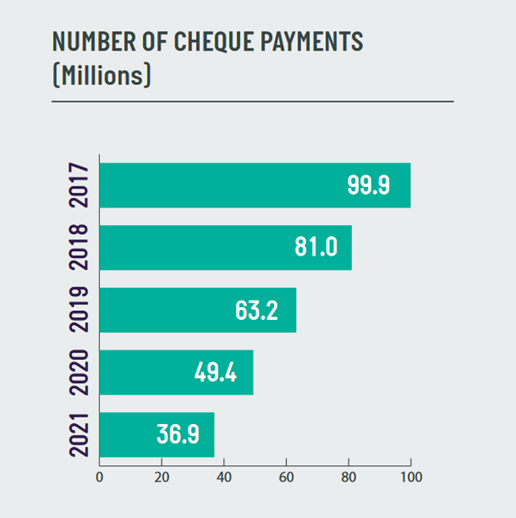
Source: RBA Payment Statistics
Charities leave cheques behind, BPAY a new choice
Charities have traditionally received millions of dollars in donations via cheques, particularly from older Australians.
Fundraising Institute of Australia (FIA) member data from 2019 showed that up to approximately 30% of fundraising revenue was received via cheques. The FIA wants to maintain cheques as a payment method although the pandemic has also encouraged older Australians to adopt digital payment methods.
More than three-quarters (77%) of Australians aged 65 and over were using online banking at June 2020 compared to slightly more than half (59%) just three years earlier, according to ACMA[3].
AusPayNet continues to work with industry bodies, including the not-for-profit sector and government, to increase awareness of the decline in cheques and of payment alternatives.
Meanwhile, some charities are now adding BPAY as a payment method, such as Rural Aid or Save the Children.
It allows the payer to confirm who they are paying at the time of payment, while the charity can issue the payer with a unique “Donor Number” as their reference.
“This makes it easy to reconcile the payment when it’s received, and they know who to send the tax receipt to,” says BPAY Group Managing Director Kim Tyler.
“Donors can also set up recurring payments using the same reference, while funds are received the next business banking day by the charity – they don’t need to wait for the cheque to clear.”
Property settlements go electronic
Another key reason for the rapid decline of cheques has been the adoption of e-conveyancing when buying a property.
Property settlement once required the buyer to hand over a bank cheque in exchange for the documents required to register them as the new property owner.
A PwC report commissioned on behalf of digital exchange PEXA estimated that up to five cheques were required per transfer and one additional cheque per discharge in 2015.
Now more than 80% of all property transfers and 95% of all refinances nationally are conducted over the digital PEXA exchange.
“The banks have enormous cost in creating and holding the cheque books,” Halverson says. “Everything about them is wrong: printing paper, the time it takes to turn them around, the cashflow you lose, and the lack of information.”
AusPayNet says it continues to monitor cheque usage into 2022, to ensure that current cheque users are not left behind as individual financial institutions ultimately make the decision that it is no longer a commercial decision to issue them.
[1] Future State of Payments Action Plan. Conclusions from AusPayNet’s Consultation. August 2020. Retrieved from https://www.auspaynet.com.au/sites/default/files/2020-08/APN_Future_State_Conclusions_Consultation_Paper_Aug20_0.pdf
[2] The Ongoing Decline of the Cheque System | Bulletin – June Quarter 2017. (2017). Reserve Bank of Australia. Retrieved from https://www.rba.gov.au/publications/bulletin/2017/jun/7.html#box-a
[3] The digital lives of younger and older Australians | ACMA. (2022, April 07). Retrieved from https://www.acma.gov.au/publications/2021-05/report/digital-lives-younger-and-older-australians
Source: BPAY Pty Ltd bpay.com.au (ABN 69 079 137 518).

A Look at Gen Z Banking Habits and Attitudes
Compared to other generations, fewer Gen Z customers expect to remain with their primary financial services organization a year from now. Do you know what Gen Z wants?
They are mobile-centric, diverse, ambitious and just starting their careers. They also have strong opinions on what they expect from their financial services organization. Our BAI Banking Outlook Special Report shares essential insights on Gen Z, the newest generation of banking customers.
Source: BAI 2022, www.bai.org

Cashless society looms: Australians tipped to move away from cash by 2025
Australians are ditching cash at the fastest rate in history as contactless payments and the boom of buy-now-pay-later methods threaten to radically reduce the use of physical money. The annual Global Payments Report predicts that in Australia, cash will account for only two per cent of value from all point-of-sale transactions by 2025. This doesn’t mean cash will only be used for two per cent of all transactions, but rather that the value of these cash purchases will pale in comparison to those made with other methods such as credit or debit cards.
The report also predicted that within two years, digital wallets (such as apps that allow customers to use their smartphone or smart device to pay) will overtake credit and debit cards to become the leading e-commerce payment method by 2024. Currently debit cards are most used payment method at the registers comprising 41 per cent of all transactions, followed by credit cards (35 per cent), digital wallets (11 per cent), cash (seven per cent) and buy-now-pay-later (four per cent). In Australia buy-now-pay-later services such as Afterpay are predicted to account for 14 per cent of all e-commerce purchases by 2025, up from its current 11 per cent. The steep decline in the use of cash comes as many Australians change their purchasing behaviour during the COVID-19 pandemic to avoid contact where possible. Analysis by the Australian Banking Association found that ATM withdrawals – perhaps the largest indicator of general cash use – decreased by 20 per cent in the year to August 2021. “COVID-19 accelerated trends in our society and changed the way we live our lives. Working from home will forever be more prominent within the workforce, we have steered away from using cash and as a result are seeing an increase in card and technology payments and the existing trend of doing banking online instead of in a branch has only continued,” said ABA chief executive Anna Bligh. “As we have seen more people go away from using branches, it’s no surprise to see banks invest in areas where customers prefer to bank, such as in their online platforms and apps. “Interestingly, one major Australian bank reported digital banking is now the primary channel for its customers aged between 16 and 69, with digital interactions up 10 per cent since 2019. This same bank reported a steady branch usage drop of 32 per cent since January 2019.” ABA data shows that one in ten Australians regularly leave home without taking their wallet, and more than one in three Australians use digital wallets on their smartphones at least weekly. As cash use declines, so too does the use of physical bank branches.
Source: 9news.com.au, Stuart Marsh, Senior Producer, 10/3/22

Auswide Bank appoints Indue as exclusive partner to deliver payments transformation
We are pleased to announce that Auswide Bank has selected Indue as their exclusive full-service payments partner.
An ASX-listed regional bank based in Bundaberg with 17 branches across Queensland, Auswide Bank has operated for more than 55 years with assets under management of more than $4 billion.
Auswide Bank has an Australia-wide lending presence supported through branches, business bankers, accredited mortgage brokers and online, and offers an extensive range of finance and banking products to help their customers realise their financial dreams.
Auswide Bank Managing Director Martin Barrett said the partnership announced today strengthens an already proven relationship, with Indue to provide end-to-end payment services that will support the bank’s digital transformation, provide a state-of-the-art customer experience and business outcomes.
“Auswide Bank has worked with Indue for 6 years and the extension of agreement is another exciting step in our relationship,” Mr Barrett said.
“Both organisations are focused on placing our customers at the centre of everything we do, and we couldn’t be more pleased to be partnering with Indue to help us continue to deliver outstanding service to our communities and customers across Australia.
“Indue will provide a full suite of end-to-end payment solutions, which is a key component of transforming our business with technology and providing digital payment choices for our customers, improving their experience and delivering stronger business outcomes.”
Indue CEO Derek Weatherley said Auswide Bank’s strategy was strongly supported by Indue’s strategy and Indue was very well placed to serve Auswide Bank in their mission to serve their customers.
“At Indue we have a deep commitment to our partners, and our ‘customer first’ approach is directly aligned to Auswide Bank’s focus on their customers and community,” Mr Weatherley said.
“This new partnership will provide Auswide Bank customers with access to a comprehensive suite of end-to-end payment services delivered through Indue’s ongoing digital transformation program.
“Indue reinvests our profits into research and development to ensure our customers are continuously able to deliver relevant payment solutions to their customers. Auswide Bank and its stakeholders will be a major beneficiary of these investments as we continue to develop and deliver these innovative payment solutions.
“Auswide Bank will benefit by tapping into Indue’s evolving suite of digital payments that bring real time, data rich, frictionless payments to customer’s anywhere, anytime, with the peace of mind brought by our market leading real time fraud and AML capabilities.
“The payment services suite provided to Auswide Bank will include Direct Entry, BPAY, NPP, Financial Crimes, Anti-money Laundering, Card Services, High Value Payments and PEXA. Auswide Bank plan to launch NPP and NPP Fraud as a matter of priority.”
Mr Weatherley said the teams were looking forward to working together for a swift transition over coming months.
-ENDS-
For more information please contact:
Indue Head of Marketing & Communications – Clare Mitchell
[email protected] – 0429 889 556
Auswide Bank Head of Marketing – Karyn Kelly
[email protected] – 0414 011695

Indue gains ISO certification for information security management
Payment solutions provider Indue today announced it had received an International Organization for Standardisation (ISO) 270001:2013 certification for information security management — one of the
most widely recognised and internationally accepted standards for the security of assets.
The ISO certification features requirements on how to implement, monitor, maintain and continually improve an Information Security Management System (ISMS) in accordance with the standard,
including preserving the confidentiality, integrity and availability of information to ensure risks are adequately managed.
Indue Chief Executive Officer Derek Weatherley said the accreditation reinforces the organisation’s proven security processes and credentials against the global standard.
“This is a significant achievement for Indue, which specialises in helping customers gain competitive advantage through innovative payment solutions,” Mr Weatherley said.
“The certification strengthens our approach to information security, and demonstrates to our customers and partners that we maintain the highest levels of data security.
“We are trusted by our customers to store and process their most valuable data, so this certification provides assurance that we have all the necessary controls in place to ensure this important information is protected.
“Particularly in the context of COVID-19 where we’ve seen an increase in the risk of data security breaches alongside a surge in online transactions, we’ve continued to demonstrate our commitment to secure payment products, supported by rigorous compliance, program oversight and our transaction monitoring and protection system, Orion Financial Crimes.”
Data security has never been more important, with COVID-19 restrictions forcing many businesses to move to remote data almost overnight, significantly increasing the risk of data breaches.
By implementing and following the necessary steps to comply with the ISO 27001:2013 standard, organisations can identify, control and eliminate security risks, ultimately certifying the security practices adopted within the organisation.
ISO is an independent, non-governmental, international organisation that develops standards to ensure the quality, safety and efficiency of products, services and systems.

Biometrics to secure over $3 trillion in mobile payments by 2025
Biometrics to secure over $3 trillion in mobile payments by 2025
A new study has found that biometrics will authenticate over $3 trillion of payment transactions in 2025, from just $404 billion in 2020.
A new study has found that biometrics will authenticate over $3 trillion of payment transactions in 2025, from just $404 billion in 2020.
The report found that biometrics, including fingerprint, iris, voice and facial recognition are becoming critical to offering compelling app experiences, as mobile payments begin to take off in the payments landscape.
The extraordinary growth of over 650% will be fuelled by increased use of OEM Pays (such as Apple Pay and Samsung Pay), for both remote and in-store payments, as these applications have already embraced biometric authentication methods.
The research recommends that all payment apps take notice of biometrics and build the most seamless user experience leveraging biometric capabilities, or risk losing out to more secure OEM Pay alternatives.

Biometric usage lagging behind hardware adoption
The research found that although biometric capabilities will reach 95% of smartphones globally by 2025, only 35% of these smartphones will be used for making biometric payments in e-commerce in the same year.
The research identified that stored card-on-file payments without biometric security remain common in e-commerce, and that it will require significant efforts by stakeholders to transition spend to biometrically-secured methods.
“While biometrics are now an established part of the ecosystem, payments and e-commerce apps have not kept pace with the rate of innovation,” explains Research co-author Susan Morrow. “Merchants must adopt biometric capabilities rapidly and educate users to best secure the increasingly massive e-commerce market.”
Contactless payments driving biometrics use
The research also found that contactless mobile payments are a major driver of increased biometrics use, with the number of contactless mobile transactions secured by biometrics increasing by over 520% between 2020 and 2025.
The research identified contactless cards as the main threat, as they do not require the extra verification step, meaning that payment vendors need to incentivise wallet use to drive greater adoption of biometrics.
Source: Alex Rolfe – Payments Cards and Mobile 2nd February 2021.
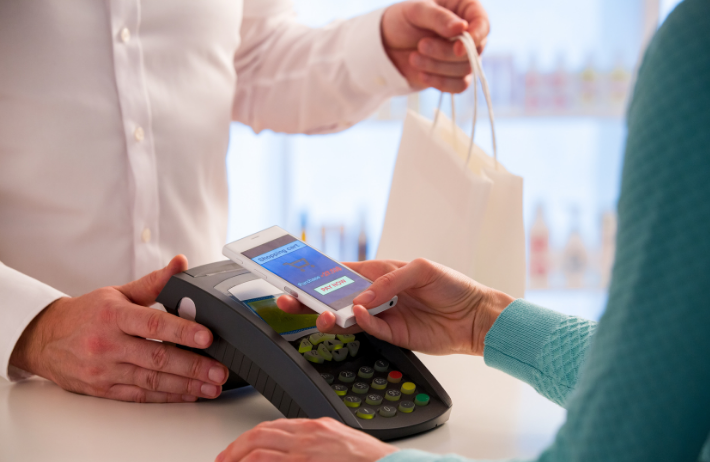
Stay COVID-safe with contactless giving | Indue Digital Gift Card
Stay COVID-safe with Contactless Giving
Contactless payment methods have never been more important. The ‘tap-and-pay’ approach to purchasing everyday essentials has well and truly become the norm, with the global pandemic forcing us to rethink our daily movements, including how we choose to pay.
The Rise of Contactless Payments
The rise of contactless payments can be seen right across the sector, made even more accessible following the temporary increase of PIN limits for contactless payments from $100 to $200 to reduce the need for physical contact with payment terminals, a move led by the Australian Payments Network (AusPayNet)[1].
This sentiment can also be translated to the gift card space. What has traditionally been a somewhat ‘hands-on’ process — from purchasing in-store to the act of giving itself — gift cards are now turning completely digital and Indue are the first in Australia to utilise the Visa network to make this happen.
It’s a move that’s in line with shifts in consumer behaviour. A 2019 survey by Roy Morgan of more than 50,000 consumers revealed 72 per cent of Australians are embracing digital payment solutions and mobile payment wallets in lieu of more traditional physical payment methods while shopping[2], and this has only been amplified as we tackle the global pandemic.
New Contactless Gift Card
Indue Chief Commercial Officer Dave Hemingway said Indue’s new contactless digital gift card offering further embeds the business’ payment expertise in the retail sector, setting a new benchmark in retail technology.
“Consumers expect fast, convenient and secure payments, and Indue is proud to redefine the boundaries to create an exciting, new product that we’re certain will benefit retailers and consumers across the country, even more so from a COVID-safe perspective,” Dave said.
“Building on our 20-year partnership with Visa, together we’ve created an entirely new product allowing major retailers to utilise a digital gift card that is universally accepted without requiring point-of-sale integration, paving the way for future advancements in this sector.”
With the widespread impacts of COVID-19 affecting several industries across the country, technology will play a key role in helping businesses bounce back. There has never been a more crucial time for retailers in particular to consider digital gift cards as a way to secure a solid consumer base and boost sales through a convenient, safe and seamless purchase journey.
In this increasingly contactless environment, the rise of innovative, digital solutions that not only streamline gift giving and receiving, but protect our overall health, will no doubt become a necessity as we continue to navigate the ‘new normal’.
Find out more about Indue’s innovative gift card offering here, or contact us today.
References
[1] https://www.auspaynet.com.au/insights/Media-Release/ContactlessLimitsCOVID-19
[2] https://www.finder.com.au/australians-digital-payments-roy-morgan-survey#:~:text=A%20new%20survey%20from%20Roy,Zip%20and%20mobile%20payment%20wallets.&text=Bill%20payment%20services%20were%20the,in%20the%20past%2012%20months.

Digital gift card convenience | A new way to give
A new digital way to give
Contactless convenience is the ultimate win for consumers when it comes to Indue’s new digital gift card offering.
Innovation in the Australian Gift Card Market
The Australian gift card market is valued at up to $2.5 billion annually[1], making it the most popular gift given in Australia. Market research has shown that while gift givers would prefer to gift something physical to convey thought and meaning, recipients generally prefer to receive digital gift cards for the convenience factor. Indue has tapped into this sentiment, creating a multi-merchant digital gift card solution, providing multiple options for the recipient to choose where they spend.
Just six months in the making in partnership with Visa, the Indue digital gift card provides the same level of security and convenience customers know and trust when they tap-and-pay on their mobile phone or wearable device. Lost or forgotten cards are a thing of the past with a balance displayed in real time, enabling recipients to check their balance on the go and removing the need to attempt multiple transactions to spend the remaining value.
Digital Gift Card Convenience
Consumers want the convenience they’ve come to expect from using their smart device for transactions, so it’s only natural that digital gift cards provide a better customer experience overall.
The digital gift card also offers added flexibility when it comes to purchasing them online, particularly around peak holiday periods.
“Digital gift cards extend the buying window at the busiest times of the year, in particular the lead up to Christmas,” said Indue Chief Commercial Officer, Dave Hemingway.
“When people are buying plastic gift cards online, that stops at around 19 December because purchasers are concerned they won’t arrive in time. Consumers now have the ability to buy a digital gift card online on Christmas Eve, with an almost instant digital delivery to the recipient.”
Find out more about Indue’s innovative gift card offering here, or contact us today.
References
[1] https://treasury.gov.au/publication/gift-cards-in-the-australian-market-report-2/gift-cards-in-the-australian-market-report/part-ii-the-australian-gift-card-market

Indue gains ISO certification for information security management
Indue gains ISO certification for information security management
Indue has received an International Organization for Standardisation (ISO) 270001:2013 certification for information security management — one of the most widely recognised and internationally accepted standards for the security of assets.
ISMS Continual Improvement
The ISO certification features requirements on how to implement, monitor, maintain and continually improve an Information Security Management System (ISMS) in accordance with the standard, including preserving the confidentiality, integrity and availability of information to ensure risks are adequately managed.
Indue Chief Executive Officer Derek Weatherley said the accreditation reinforces the organisation’s proven security processes and credentials against the global standard.
“This is a significant achievement for Indue, which specialises in helping customers gain competitive advantage through innovative payment solutions,” Mr Weatherley said.
“The certification strengthens our approach to information security, and demonstrates to our customers and partners that we maintain the highest levels of data security.
“We are trusted by our customers to store and process their most valuable data, so this certification provides assurance that we have all the necessary controls in place to ensure this important information is protected.
“Particularly in the context of COVID-19 where we’ve seen an increase in the risk of data security breaches alongside a surge in online transactions, we’ve continued to demonstrate our commitment to secure payment products, supported by rigorous compliance, program oversight and our transaction monitoring and protection system, Orion Financial Crimes.”
Data security has never been more important, with COVID-19 restrictions forcing many businesses to move to remote data almost overnight, significantly increasing the risk of data breaches.
By implementing and following the necessary steps to comply with the ISO 27001:2013 standard, organisations can identify, control and eliminate security risks, ultimately certifying the security practices adopted within the organisation.
ISO is an independent, non-governmental, international organisation that develops standards to ensure the quality, safety and efficiency of products, services and systems.

New digital gift card a win for retailers
Indue’s new digital gift card a win for retailers
Indue, in partnership with Visa, is transforming the gift card experience for Australian retailers and consumers with its innovative new offer.
A convenient, contactless payment option
Paving the way for future advancements in the sector, the new digital gift card allows major retailers to offer a digital gift card that is universally accepted, without requiring point-of-sale integration.
In addition to offering a convenient, contactless payment option for consumers, the product also provides the ability to capture consumer data to generate targeted engagement. Recipients of the digital gift card are required to download the retailer’s app in order to provision their digital gift card into Apple Pay or Google Pay, creating an opportunity to gather purchasing metrics, serve up additional offers to consumers and link in to the broader shopping experience.
Enhancing Consumer Engagement
“There’s no ability to connect with a consumer when they use a plastic gift card — it’s an anonymous transaction. Our digital gift card technology, which integrates seamlessly with retailers’ existing apps, encourages tighter engagement,” said Indue Chief Commercial Officer, Dave Hemingway.
“Our mission is to ensure the millions of Australians who access their money through our clients’ companies have access to market-leading payment products, and we’re thrilled to have delivered once again with our digital gift card.”
Operating costs for retailers who offer digital gift cards are also lower, removing the need to pay for manufacturing and distribution. Expiry dates for many gift cards need to be printed on the card at the time of manufacture, which could result in stock issues if the cards are unable to be sold within a set period, whereas Indue’s digital gift cards generate an expiry date at the point of purchase.
Importantly, Indue’s digital gift card is flexible in its deployment, providing both B2C and B2B distribution solutions.
“Digital gift cards don’t necessarily need to be distributed via e-commerce. For example, we’ve had enquiries around digital gift cards to distribute to staff as part of a loyalty program, so there are a range of different distribution models that we can harness,” Dave said.
Find out more about Indue’s innovative gift card offering here, or contact us today.
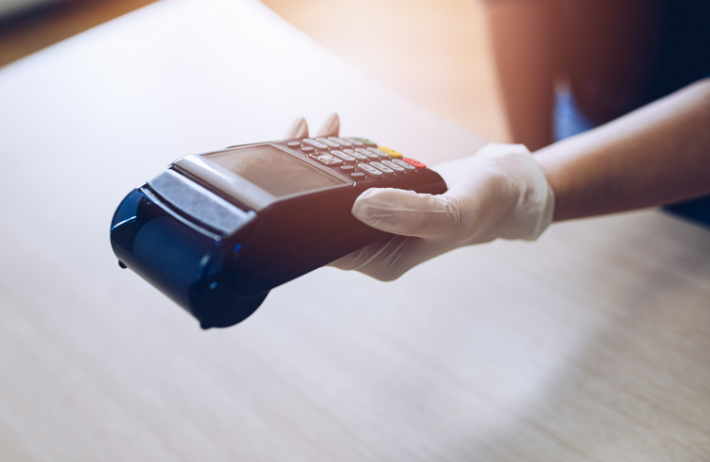
2020 Pandemic: How might it change the ways we pay?
2020 Pandemic: How might it change the ways we pay?
Although the total number of payments in the Australian market is currently suffering a severe decline, as economic activity is strongly curtailed, what might happen to the ways consumers pay after the 2020 pandemic? Guest writers, David Oierholm and Lance Blockley of The Initiatives Group, offer their view.
The COVID-19 2020 Pandemic is having an unprecedented impact on how we live and work. We are planning for the worst and hoping for something better. No matter how long it takes for the crisis to pass, 2020 will be a year that is not forgotten quickly.
It will undoubtedly be a period of change, some of which will alter the way we do things forever.
We are likely to wash our hands more frequently, and we will be much better at conducting remote meetings using platforms such as Zoom, Webex, Skype for Business, GoToMeetings, etc. Telemedicine will likely become more prevalent, as will the ability and propensity to work from home effectively.
We will be super-sensitised to microbes, and, given the economic impacts being experienced, we may be more concerned about the sustainability of the companies we buy things from, together perhaps with more conservative views regarding our ongoing employment and income. Indeed, the cross-border supply chains that have been constructed over the last 15+ years of globalisation have been shown to be a potential weakness (e.g. a key global production site of surgical masks being in Wuhan), so perhaps domestic manufacturing will get a boost everywhere and cross-border commercial transactions decline.
Although the total number of payments in the Australian market is currently suffering a severe decline, as economic activity is strongly curtailed, what might happen to the ways consumers pay? Not necessarily in the short term – although many merchants are now refusing to take cash, travel card issuance & usage has crashed, and cross-border payments (a key revenue source for the international schemes) are drying up. Rather, we are looking at the potential longer term residual impacts.
In The Initiatives Group white paper “The Changing Face of Consumer payments in Australia”, we identified that the way we pay takes a long time to change. It is all about trends, and long ones at that. The following graph was used to show how the ways we pay have changed over the past 15 years. The trends are clear – cash and cheques are on the decline, and fast becoming in the minority of transactions. Electronic payments continue to increase. Cards are now more than 60% of transactions, with the growth in debit cards far outstripping credit cards. It is now quite normal to pay for a morning coffee (currently only available as “take away”) using a card – not so long ago a $3.50 purchase would have been made with cash.
The trends are clear – cash and cheques are on the decline, and fast becoming in the minority of transactions. Electronic payments continue to increase. Cards are now more than 60% of transactions, with the growth in debit cards far outstripping credit cards. It is now quite normal to pay for a morning coffee (currently only available as “take away”) using a card – not so long ago a $3.50 purchase would have been made with cash.
What might happen to cash?
“Fed Plans Release of Clean Cash As Virus Spreads” (pymnts.com, March 22, 2020)
The decline in the use of cash will accelerate, along with an associated decline in ATM usage (noting that for every ATM withdrawal that does not happen, an additional 10-15 electronic transactions will be generated, mainly on debit cards).
 Cash carries bacteria 1 (no prior studies seem to have focused on viruses!). Both cash and bacteria travel fast. Even though it has been found that polymer notes, like those used in Australia, carry less bacteria than (absorptive) paper notes such as those in the USA and China, consumers and merchants alike will be less keen on handling cash, and more keen on using electronic payments. Indeed, the UK has just lifted the contactless limit from GBP30 to GBP45 to help further reduce the use of cash. More locally in Australia, one of your authors has found that cash is no longer accepted at the local Coles Supermarket, Harris Farm Markets and the golf club (which is closed for now anyway).
Cash carries bacteria 1 (no prior studies seem to have focused on viruses!). Both cash and bacteria travel fast. Even though it has been found that polymer notes, like those used in Australia, carry less bacteria than (absorptive) paper notes such as those in the USA and China, consumers and merchants alike will be less keen on handling cash, and more keen on using electronic payments. Indeed, the UK has just lifted the contactless limit from GBP30 to GBP45 to help further reduce the use of cash. More locally in Australia, one of your authors has found that cash is no longer accepted at the local Coles Supermarket, Harris Farm Markets and the golf club (which is closed for now anyway).
So, are plastic cards the answer?
Australians are the world leaders in the use of contactless open-loop payments, with well in excess of 90% of card present transactions being contactless. This means that, for transactions under $100, we don’t need to touch a terminal that somebody else has used or handed us. We also don’t have to hand our card over to a stranger. That’s good, right?
Well, maybe not… unfortunately there are studies, albeit in the USA, where contactless payments are still in their infancy, that have shown that cards “can be grimier than cold hard cash”.2
However, it still feels safer to use a card that only you have held than notes and coins that have gone through multiple hands, so plastic cards will quickly pick up transactions from cash.
How about other transactions that use the card rails?
Mobile Wallets
Despite the high ownership of smartphones and Australians’ love of contactless payments, until recently, the take up of mobile wallets such as Apple Pay, Google Pay and Samsung Pay (the “Pays”) has been slow. It may depend on your industry and your demographic, but The Initiatives Group has heard conflicting reports. Claims of 25% of POS transactions being handled via the Pays have been offset by merchant claims of far far lower percentages, hence we would suggest that the average across all contactless payments is still under 10%.
Regardless, the use is set to accelerate. Your phone may or may not be a great carrier of bacteria, but it is something you will touch anyway, so what’s the difference if you now use it for payments and avoid fiddling around with your wallet for a card.
Wearables
Whilst wearables are only another form factor for using the Pays, their use is likely to increase as an even more “contactless contactless” form of payment. Notwithstanding we believe that wearables, perhaps other than smart watches, will remain relatively niche.
In-app payments
In-app payments are likely to be a big winner from the COVID-19 crisis. Seamless payments will be the most contactless of contactless payments. Whilst in the short-term popular use cases such as Uber transport will take a significant hit, there will be many new use cases that become available earlier or even more popular – think of ordering home delivery (from supermarkets, for prepared food e.g. Menulog, Ubereats) and petrol stations (where something like the Caltex app avoids the need to enter the shopfront). We will be more ready to form new “safe” habits, and, if used frequently enough, these use cases will be habit forming, just as the adoption of contactless card payments was slow until Woolworths and Coles offered them (back in 2012).
We found the new 13cabs “No Touch Parcel Deliveries” of interest. Whilst no-touch may not be as big a deal from 2021, here is another reason to get into the habit of using in-app payments for taxi services. In the future will we see the groceries delivered paid within the 13cabs app, or the taxi delivery paid for within the Coles or Woolworths app?
Peer to peer payments
As handling cash becomes less popular, might we now see electronic peer to peer payments use accelerate. Perhaps this will provide stimulus to the use of PayID, Beem It and card-tocard systems. Although current social distancing and work-fromhome orders may well diminish the need to pay our friends and relations in the near term.
eCommerce card not present
In the short-term, eCommerce spend on travel and discretionary items has tanked, however online ordering of grocery goods and fresh foods is up globally. Discretionary spend, such as fashion, will recover once people are again allowed to physically interact. Grocery and fresh food ordering online will be a new habit – whether for home, work or locker delivery, or click and collect. Although it may not maintain at COVID-19 levels, this will likely fuel more rapid long term growth in eCommerce retail spend.
Monthly payments
The economic impact of potential (or actual) unemployment, of recession and of media noise about depression, will all make consumers more wary of both the sustainability of companies that they deal with and their own ability to pay in annual large lump sums. We predict this will lead to a preference for annual payments to be made monthly (already a trend before the crisis), and not necessarily by auto direct debit (as consumers may wish to retain control). In addition, this preference may lead to consumers demanding that they are not penalised with any surcharge for paying monthly.
Noting that, just as the decline in ATM use accelerates the volume of electronic payments, so too does monthly payment . . . 12 transactions rather than one.
New products
Adversity is often the mother of invention, so it is likely that we will see a range of new electronic payment products, use cases and services being created.
Opportunities only for the card rails?
An emphatic “No”. As noted above, online real-time payments over the NPP may be accelerated – whether by Osko, other overlay services or by ‘pay anyone’ (previously via direct entry) payments growing faster. The increased volumes allowing the NPP to become less expensive per transaction.
Perhaps a trend towards mobile phone payments will improve the use case for NPP payments on your phone at POS, enabled by QR codes? Notwithstanding, we do expect that there will be even more new overlay service activity that takes advantage of the NPP.
Conclusion – How might Covid 2020 Pandemic Change the Way We Pay?
The current COVID-19 crisis will see payment volumes drop sharply as economic activity stalls. Within the remaining payment activity, the mix of payments will change:
- The reduction in cash and ATM usage that has been occurring over many years will accelerate into a steep decline
- The cross-border usage of payment cards will drop to low levels
- Use of contactless card and mobile payments will rise
- Use of remote services/ordering, and with them the associated remote payments (eCommerce, in-app, other online), will increase
- A move to monthly payments.
Depending upon the length of the crisis, many of these changes will become habitual and are likely to outlast the short term impact of the virus – such that the retail payments mix in the Australian economy will be altered forevermore.
Disclaimer: The opinions expressed in this article are the author’s own and do not necessarily reflect the view of Indue. The Initiatives Group has advised participants in the payments market since the 1990’s – including issuers, acquirers, third-party processors, technology providers and associations. The Initiatives Group has a strong relationship with Indue, and can help participants in the payments sector generate more value from their markets and customers. To find out how, please get in touch.
Sources:
1 A Oxford University study in 2014 found that the average European banknote contained 26,000 bacteria which could be potentially harmful to a person’s health; and market research has found the majority of European consumers rank physical money as being more unhygienic than the hand rails on public transport
2 https://www.fastcompany.com/90480199/how-companies-can-support-their-employee-caregivers-duringthecovid-19-outbreak

3DSecure 2.0 – eftpos Enters the Fray
3DSecure 2.0: eftpos Enters the Fray
With the introduction of 3DSecure, eftpos has continued its journey to ensure its cardholders have the highest standards in transactional security without adding unnecessary friction to the cardholder experience.

3DSecure – Securing Payments
3DSecure (3Ds) is a security protocol that provides an additional layer of protection for cardholders and merchants alike for card-not-present (CNP) eCommerce transactions. It is used to authenticate the cardholder whilst undertaking a payment, ensuring that the person conducting the transaction is indeed the cardholder.
The purpose of the 3DS protocol is to facilitate the exchange of data between stakeholders – the merchant, cardholder and card issuer. The objective is to benefit each of these parties by providing the ability to authenticate cardholders during a CNP eCommerce purchase, reducing the likelihood of fraudulent usage of payment cards.
Issuers of Visa and MasterCard card products have already been exposed to 3DSecure 1.0 and its recent version 2.0 successor in the form of ‘Visa Secure’ and ‘MasterCard SecureCode’, respectively.
Indue is finaliaing a program of work with all of its Visa card issuing clients to upgrade Visa Secure version 1.0 to version 2.0. Version 2.0 introduces the requirement to have dynamic cardholder verification (i.e. one-time password via SMS) instead of static cardholder verification (i.e. cardholder identity questions).
eftpos enabling 3DSecure 2.0
Based on industry feedback and continual working groups, eftpos has undertaken the same initiative as the other card schemes and has commenced the process of establishing its own 3DSecure requirement. The scheme is currently working on finalising its solution design and technical specifications.
Indue has advocated to eftpos that its 3DSecure solution be compatible with the other card schemes’ solutions – namely Indue wants to ensure that eftpos’ final solution design allows the reuse of what its card issuing clients have already built to support the other schemes’ solutions. This would ensure that eftpos cardholders benefit from the same security protections as other scheme cardholders whilst leveraging the effort already expended to build a 3DSecure solution.
Implementation Timeline
The eftpos 3DSecure 2.0 solution is currently in planning phase. eftpos is presently working with existing Access Control Servers (ACS), who provide the authentication solution software for issuers and merchants for 3DSecure, to finalise their own set of requirements.
eftpos have yet to confirm a set date for their finalised 3D Secure solution, but have advised that by October 2020, there will be a liability shift favouring those parties who have opted to enroll and implement the new security solution. The same strategy was previously employed by other card schemes in order to promote adoption and ensure that both parties within a transaction (merchant and card issuer) are protected against card fraud.
Once Indue has received eftpos’ detailed requirements for 3DSecure functionality, we will undertake further analysis to understand the changes and engage all of our affected eftpos Card Issuers to initiate a project for implementing the solution.

Tokenisation – What is it and can it beat payment fraud?
Tokenisation – What is it and can it beat payment fraud?
Tokenisation seems to be one of the key buzzwords in the payment industry at the moment. However, what does this concept really mean and how does it benefit payments made today?
What is Tokenisation?
Tokenisation is a method of protecting sensitive data by replacing it with an algorithmically-generated number referred to as a ‘token’. In the payments world, tokenisation is commonly used to replace debit and credit card numbers in an attempt to prevent card fraud.
Under this form of tokenisation, a cardholder’s Primary Account Number (PAN) is replaced by a random number that is not linked to the card number prior to processing a transaction through the payments network. This process assists in mitigating the risk of exposing sensitive card data to unauthorised individuals or software that could potentially exploit the data by fraudulently duplicating the card details. It also prevents merchants from storing the PAN in databases, which are targets for hackers. Tokens cannot be decrypted or reverse-engineered. The only relationship between the original card number and its associated token number resides within the Token Service Provider.
What is a Token Service Provider?
A Token Service Provider (TSP) is a service provider that issues tokens, manages the lifecycle of tokens and stores the payment credentials associated with the tokens. TSPs can be an independent third party from the payment network or can be the actual card scheme (i.e. Visa, MasterCard, eftpos). TSPs must conform to strict security and privacy specifications defined by the global payment schemes and fall within the PCI-DSS compliance requirements.
Tokenisation in the Industry
Tokenisation takes many forms within the payments industry. One of the most prevalent uses of tokenisation is within the Mobile Payments space. When a cardholder provisions their payment card within an Apple or Google mobile wallet, the request is sent to the appropriate TSP to tokenise the card number. The token is then sent back to the mobile wallet for activation. The cardholder’s actual card number is never stored on the mobile device and as such cannot be extracted for misuse. All subsequent mobile transactions will use the token number as the payment credentials.
 Tokenisation for in-app purchases is also on the rise due to its convenience. Some in-app purchases leverage the mobile payment functionality whereby the token stored on the mobile wallet is used to make a purchase within the phone application. An example of this would include purchasing tickets on the Ticketek app and instead of inputting credit card details, the user is able to select the Apple Pay option, which references the credentials stored within the mobile wallet. Not only does this option provide an easy streamlined purchase journey, it also removes any sensitive data from the transaction.
Tokenisation for in-app purchases is also on the rise due to its convenience. Some in-app purchases leverage the mobile payment functionality whereby the token stored on the mobile wallet is used to make a purchase within the phone application. An example of this would include purchasing tickets on the Ticketek app and instead of inputting credit card details, the user is able to select the Apple Pay option, which references the credentials stored within the mobile wallet. Not only does this option provide an easy streamlined purchase journey, it also removes any sensitive data from the transaction.
Tokenisation for card-on-file online purchases is also becoming more common given the recent occurrences of global data breaches. Wawa, a popular convenience store chain in the United States, confirmed in late 2019 the discovery of malware on their payment processing servers. The malware captured credit and debit card numbers, cardholder names and expiration dates. Card-on-file tokenisation protects a cardholder’s card credentials stored at online merchants with whom the cardholder frequently make purchases. Netflix holds the card credentials of all its customers for the purpose of charging the monthly subscription fees. The streaming service provider has recently undertaken a significant exercise of tokenising as much of its database as possible as a means to mitigate the risk of data breaches. As more online merchants migrate to tokenisation, the prevalence of card data breaches will hopefully decrease as well. Given that a new unique token is generated for each retailer, a security breach at one retailer will not compromise the security of the token data at another retailer.
Payment Account Reference – Providing a holistic view
Although the use of tokenisation enhances the security of digital payments, it also presents a challenge. If a cardholder’s card credentials are tokenised for use within Google Pay on an android phone, Apple Pay for an iPad and Netflix for monthly subscription payments, it becomes a one to many relationship. One single PAN is now linked to several tokens across different systems and platforms.
As only the TSP has the original data linking the PAN to the multiple tokens, the lack of visibility makes it difficult for other parties such as merchants to have a consolidated view of all transactions performed by the cardholder and subsequently provide value-add and compliance services. An example of this is the provision of fraud and anti-money laundering monitoring services. To provide the most effective service, there is a need to identify transactions on an aggregate card level to better assess customer behaviour and payment trends.
As a means to provide a consolidated view, some card schemes have introduced the use of a Payment Account Reference (PAR). According to a recent white paper published by EMVCo, a global entity facilitating worldwide interoperability of secure payment transactions, a PAR is a ‘non-financial reference assigned to each unique PAN and used to link a Payment Account represented by that PAN to affiliated Payment Tokens’. PAR is passed in the transaction message to the merchant so that they can reference this field when performing customer level analysis.
EMVCo affirms that this is a long term solution that will solve the issue by linking together disparate card-based and token-based transactions without compromising on security. Although this is the recommendation of EMVCo, it is the responsibility of the card payment schemes to adopt this concept and implement it into their respective payment ecosystems. eftpos is introducing support for PAR in the near future.
Resources:

Insight: The changing face of consumer payments in Australia
Insight: The changing face of consumer payments in Australia
Our guest writer, David Oierholm, Director of The Initiatives Group, sheds light on the changes and trends of consumer payments in Australia.
The ways in which consumer payments in Australia are made is often likened to a train system comprised of the “rails” that carry the carriages (the payment systems), and the “carriages” that carry the passengers (the individual payments).
The media will have us believe that the payments landscape in Australia is constantly and rapidly changing. To an extent this is correct – but this is all about new “carriages” rather than “rails”.
Furthermore, simply because there are new ways to pay on offer, it does not mean that we all immediately change the way we pay. For example, it took well over 5 years for both BPAY and (much later) contactless card payments to become mainstream.
In Australia, there has only been one new set of rails introduced in the past 25 years (The New Payments Platform (NPP), 2018)
The Way We Pay
It is about trends, and long-term ones at that. The following graph shows how the ways we pay (our use of the rails) have changed over the past 16 years, exhibiting slow movements and not, as many media commentators would suggest, overnight leaps.

The trends are clear – cash (as proxied by ATM withdrawals) and cheque usage are on the decline, and fast becoming the minority of transactions. Electronic payments continue to increase. Cards now account for more than 50% of all payment transactions, with the growth in debit card activity far outstripping credit card since 2007. It is now quite normal to pay for a morning coffee using a card – not so long ago a $3.50 purchase would have been made with cash.
Will cash and cheques ever completely disappear? It is more likely that cheques will disappear, but only when the industry and/or regulator set a termination date – otherwise someone, somewhere will keep using them. However, the ability to access and use cash is considered critical for members of society who may be unbanked, and for remote residents where electronic payments may either be unavailable or inconsistent. Even in those economies closest to being cashless, such as Sweden, there are government requirements for the economy not to become cashless – at least not until no one is left behind or disenfranchised.
In 2019, the San Francisco Board of Supervisors passed a law requiring that all bricks and mortar retail businesses must accept cash – this even includes the Amazon Go stores (more about them later). This move is to make sure that the city’s poorest residents are not shut out of access to basic goods and services. Whereas “cash not accepted” signs are common in shops in Sweden.
The Rails
The rails for electronic payments in Australia include the card rails (Visa, Mastercard, Amex, eftpos), the rails for direct entry and direct debit payments known as BECS (Bulk Electronic Payment System), the real-time payments rails operated by New Payment Platform Australia (NPP) and the international bank to bank transfer rails (SWIFT). The only one of these sets of rails that has been introduced within the last 25 years is the NPP, launched last year.
(Source: The Initiatives Group)
The Carriages
What runs on the rails is where the new action has been, as a plethora of “veneers” have been placed on top of the payment rails, giving the perception that the movement of money has changed. What has changed, and greatly, is the consumer interface, which has become more convenient, simple to use, frictionless and seamless. But, as noted earlier, just because a new way to pay is being offered there is no guarantee that it will be used.
Mobile Wallets (Mobile Payments)
Mobile wallets such as Apple Pay, Google Pay and Samsung Pay, otherwise known as “The Pays”, have arguably received more media headlines than any other payments related topic over the past few years. Despite this, it is estimated that they represent fewer than 5% of card present transactions, albeit that there now seems to be some acceleration in the adoption rate.
Requiring a credit or debit card to fund a transaction, The Pays operate on the Visa, Mastercard, American Express and, to a lesser extent, the eftpos rails. They have been offered in Australia since 2015 when Apple Pay was launched with Amex.
Even though some would describe it as simply a new “form factor” – a contactless payment (now over 90% of card present transactions) using a phone rather than a plastic card – the rollout through the payments industry has been slow. A popular hypothesis is that using your phone currently offers little benefit over using a plastic card – that is, there is no value added.
In addition, there has been significant reticence amongst the major banks to fund the fees payable to Apple Pay, which also comes with the limitation of no other application being able to access the NFC interface on the iPhone. However, as of today the only major Australian bank that does not offer Apple Pay (considered the vanguard of The Pays) is Westpac, so it is felt that the current low usage rates will increase to more significant levels over the next few years, assisted by use on mass transit.
A different type of mobile wallet where you can “pre-fund” your account prior to purchase (or link to a “top up” source of funds) is particularly popular in China, and increasingly so throughout Asia. AliPay and WeChat Pay both from China are prime examples.
When making purchases, these systems run on their own sets of rails with the transaction driven by a QR code interface (overcoming Apple’s NFC quarantine). This has permitted significant growth in electronic payment acceptance due to the simple and low cost set up for the payee. However, to fund the account, money is transferred from the user’s card or bank account.
This means the funding uses existing payment rails. To date the use of QR codes in payments in Australia has primarily been limited to visiting Chinese tourists. Australians are already well served by NFC contactless payments, so, whilst there may be more value-adding capability within a QR code, there is little incentive for consumers to change.
Another popular wallet, although not so much in mobile format (at least not in Australia), is PayPal. Created as a payment wallet to make secure online transactions, the PayPal wallet can be instantly funded by a credit or debit account, or pre-funded. An interesting contrast is that in the US keeping funds in a PayPal wallet is popular, whereas in Australia it is not.
In-app Payments or “payments in the background”
Popularised by the success of the Uber rideshare app and the “just get out of the car at your destination and walk away” payment experience, in-app payments are the topic of a separate whitepaper published by The Initiatives Group.
Sometimes criticised for making it too easy for consumers to overspend as they do not have a “transaction moment” to reconsider their purchase, in-app payments are growing even faster than e-commerce. Prime examples include Uber – familiar to most of us; Grab, which dominates carshare in South East Asia, and which is now promoting its payment service in its own right as “GrabPay”; and the Hey You (Beat the Q) café pre-order and payment aggregator app.
In the USA, Starbucks is prolific enough to have its own pre-order and payment app, which accounts for a significant proportion of their sales and is integrated with the Starbucks Loyalty program. Further loyalty integrations are underway. For example, in the USA you can use American Express Membership Rewards points to pay for your Uber ride. Amazon is taking the in-app, seamless shopping and payment experience to the nth degree, (possibly out of the budgetary capabilities of most retailers) with its Amazon Go “no lines, no checkout” concept stores, it is extreme but an insight into what is already possible!
In Australia, Woolworths is currently trialling “Scan & Go” with selected Woolworths Rewards loyalty members in Sydney – it is a variation on Amazon Go, where shoppers scan items when they take them from the shelf and then just tap off when leaving the store. This is important, as Woolworths and Coles are able to move the market: it was really not until they adopted the NFC technology that contactless payments became commonplace in Australia.
The Form Factor
Many innovations on the existing payment rails are actually changes in the form factor. As noted earlier, mobile payments are, for the most part today, simply the ability to use your phone to make a contactless card payment, rather than use the physical card itself.
Other new form factors include smart watches, including the Apple watch, Samsung Gear watches, as well as Garmin and Fitbit with Garmin Pay and Fitbit Pay respectively. Similarly, there are wrist bands and tabs attached to watch bands, even sunglasses and jewellery, such as the Bankwest Halo Payment rings. Current opinion is that these “wearables” will become popular, but amongst niche groups rather than the general population – for example waterproof bands and rings for swimmers, surfers, runners and cyclists.
BPAY and Pay Anyone
BPAY and Pay Anyone (Direct Credit on internet banking or a banking app) are payment methods that use the BECS Direct Entry system. Both allow for bank account to bank account transfers five days a week (excluding Public Holidays), with banks transferring funds 5 times per day (but not necessarily posting them to accounts that frequently).
Reliable, secure and low cost, however it is possible that a transfer can take some time to occur or appear in the receiving account – if the transfer is made late on Friday afternoon and is to a bank that is not posting intra-day settlements it may not be until the following Tuesday that the funds appear in the recipient’s account.
Whilst BPAY volume continues to grow, BPAY now somewhat competes with itself as the provider of the first “overlay” service “Osko” for the NPP, which allows real time payments between consumers and businesses via BSB and account number or with a registered PayID (mobile number, email address or ABN) linked to their bank account. Further, a number of Financial Institutions have and are moving their Pay Anyone / Direct Credit transactions onto the NPP rails, instead of using BECS.
P2P (peer-to peer) Payments
Particularly popular in geographies as diverse as the USA and China (perhaps due to the antiquated and previously limited payment systems available), P2P payments allow instant payments between consumers – splitting the bar tab, paying your share of the rent, getting money to the kids quickly, etc.
Venmo (now owned by PayPal) in the USA and WeChat Pay in China are prime examples. Both allow instant payments between other Venmo or WeChat Pay users from a pre-funded wallet. Perhaps they could be considered alternative rails, however, funding still comes from the existing rails transfer methods as these are linked to accounts.
In Australia, BeemIt allows P2P payments between BeemIt users, requiring only a Visa or Mastercard debit card for registration. Interestingly, BeemIt accesses bank accounts by using Visa and Mastercard for the authorisation messaging, then uses the eftpos rails to achieve the instant funds transfer.
As with many new ways to pay, BeemIt has not (yet) become popular in Australia as it has yet to gain sufficient penetration or ubiquity, and perhaps does not solve a significant problem that Australian consumers have (given the various other ways that they have to pay).
Real-time Payments
The establishment of real time payments platforms, moving and posting money between accounts 24×7, such as Australia’s NPP, is a major global trend. The UK has had “Faster Payments” and Singapore “FAST” for some time. More recently, Malaysia “DuitNow” and TCH (“The Clearing House”) in the USA have introduced real time payment platforms.
The NPP was launched in February 2018, the first new payment rails in Australia for 25 years (the prior launch was BECS in 1993). The NPP is an initiative that was primarily driven by the Reserve Bank of Australia, following its review of innovation in payments, and is co-owned by 13 banking organisations. It allows for real time payments between bank accounts.
 To date, it has been held back by a somewhat uncoordinated introduction through the banking system. Whilst over 2 million PayID’s have been registered, use of the Osko payment “overlay service” has been relatively limited. This is likely to change once all banks deliver the range of features available, more entities register PayID, and business applications such as “Request to Pay” and a central consent management platform are delivered (effectively allowing Direct Debit transactions to be introduced by the NPP).
To date, it has been held back by a somewhat uncoordinated introduction through the banking system. Whilst over 2 million PayID’s have been registered, use of the Osko payment “overlay service” has been relatively limited. This is likely to change once all banks deliver the range of features available, more entities register PayID, and business applications such as “Request to Pay” and a central consent management platform are delivered (effectively allowing Direct Debit transactions to be introduced by the NPP).
Even Sweden’s “Swish” success story has taken almost 7 years since its establishment in 2012 to reach a total of 1 billion transactions through the system.
Use cases range from instant P2P payments, to real time payment of employee wages, superannuation, even to the ability to safely buy/sell a used car privately on the weekend without the need for cash transfers or bank cheques.
(Image Source: Osko.com.au)
Real-time / Faster Cross Border Payments
Cross border account to account payments have primarily been the domain of Swift and its 165 member banks. Even if the origin or destination banks are not members, the 165 banks can act as “correspondent” banks to route funds into the recipient country and currency, then onto the recipient bank. It is reliable, but can be slow, opaque and relatively expensive. The Swift rails also enable currency transfer services such as Western Union.
Faced with the emerging faster cross border payment challengers, such as crypto currencies, Ripple, Visa B2B Connect, and Visa and Mastercard acquiring FX transfer platforms, Swift has been developing faster, lower cost transfer products to enhance its existing rails. Swift GPI (Global Payment Innovation) is now conducting faster cross border payment trials, and is poised for rollout network wide.
Swift, which also provides the distributed switching platform for Australia’s NPP, is also testing its involvement in integrating the different real-time payments platforms between countries.
Thought too slow and expensive (today) for domestic payments, cryptocurrencies and distributed ledger technology is of interest for the future of cross border payments, although there is a long way to go. For example, Bitcoin transactions can occur at between 10-20 transactions a second (versus Visa at up to 56,000 per second), and crypto currencies are infamous for the volatility of their value in fiat.
However, the announcement in June 2019 of the Libra Foundation, with its bundled currency backed blockchain based “stablecoin”, and the Facebook developed Calibra payment wallet (planned to be the first wallet for Libra transactions) has generated significant excitement and debate. Whether or not is succeeds (or even permitted to launch by regulators), it raises the possibilities of western “bigtech” finally entering the payments (and broader financial services) category, and the possibility of a truly global currency that transcends fiat currencies and national borders – at the same time, reaching one of the world’s broadest social network audiences.
Will Libra run on new rails? Within the Calibra wallet this is likely, but Libra ultimately still needs to be funded from some other electronic source such as a bank account or card (even if unbanked users pass cash across the counter at “agent” locations). Indeed, it has been suggested that, to reach merchants for POS transactions, it may use the Visa and Mastercard rails.
There will be many legislative hurdles to overcome, and, in developed countries such as Australia with highly developed payments systems, there remains the question of what real problems are Libra and Calibra really trying to solve (maybe remittances?).
Use cases range from instant P2P payments, to real time payment of employee wages, superannuation, even to the ability to safely buy/sell a used car privately on the weekend without the need for cash transfers or bank cheques.
Buy Now, Pay Later (BNPL)
With millions of customers in Australia, the USA and soon in the UK, “I’ll AfterPay it” is becoming a familiar expression. AfterPay, Zip Money, Humm and SplitIt have become particularly popular amongst millennials – Afterpay claims 69% of its users are 18-35 years old.
New way to pay, on new rails? No. Latitude and Flexigroup have been offering interest free payment plans for decades, and products such as Afterpay rely on debit and credit cards to make initial payments and subsequent repayments.
However, Afterpay and its cohort have tapped a rich vein of new business – millennials who are not migrating to credit cards, with a short-term low value instalment payment product, tuned initially for online purchases and delivered digitally. Merchants with a sufficient margin structure to absorb the 4-6% fee, see the additional sales as a boon in what is currently a tough retail environment. Add to this a group of BNPL businesses, those delivering similar products to small businesses, such as ProspaPay.
Conclusion – Consumer Payments in Australia
The adoption of electronic payments by consumers and businesses in Australia continues apace, pushing cheque and cash transactions (although not the amount of cash on issue) into a relatively steep decline. Consumer payments are dominated in volume by card-based transactions, but the format of these is starting to become “buried” under layers of “veneer” interfaces, many of which rely on card-on-file for their funding source.
To the consumer, these veneers look like “new ways to pay” and certainly deliver the more convenient and seamless experience that people seem to be seeking. But underneath, the funds are moving between the payer and payee accounts as they have always done.
The new rails provided by the NPP will not generate any new transactions in the market, but will take volume from existing systems. For the sake of efficiency and the economy, one hopes that the NPP will accelerate the decline in cash usage and lead to the termination of cheques. But it will also take volume from Direct Entry and card payments. Just as Swish has entered ecommerce and the point of sale market in Sweden, once the cost of NPP transactions reduces (as it should with volume growth) then one would expect it will also appear in the online and POS environments.
The increasing use of electronic payments in Australia should see the overall cost of payments as a percentage of GDP decline and the tax take through GST and income tax rise – both of which are beneficial for the country.
Disclaimer: The opinions expressed in this article are the author’s own and do not necessarily reflect the view of Indue. The Initiatives Group has advised participants in the payments market since the 1990’s – including issuers, acquirers, third-party processors, technology providers and associations. The Initiatives Group has a strong relationship with Indue, and can help participants in the payments sector generate more value from their markets and customers. To find out how, please get in touch.

eftpos: Making Digital In-roads (Digital Acceptance Pilot)
eftpos: Making Digital Inroads (Digital Acceptance Pilot)
eftpos, in conjunction with Indue clients, has successfully conducted a digital transaction in the Digital Acceptance Pilot program.

It has been quite a busy year for eftpos. With the increase in the number of banks offering merchant choice routing, (which enables merchants to choose to route transactions via their preferred network) and enabling mobile payments via the eftpos network, eftpos has definitely advanced its value proposition for its customers. One key initiative that is critical to the eftpos network ecosystem is its Digital Acceptance Pilot program.
This aligns with eftpos’ commitment to updating its product suite to continually meet changing merchant and consumer needs.
Digital Acceptance Pilot Program
Digital development will continue to be a key focus for eftpos over the coming year as Australians change the way they pay for goods and services.
This functionality enables eftpos cardholders to make online purchases at participating merchants using their eftpos card,. This is an unprecedented capability for the scheme.
eftpos collaborated with all parties within the transaction journey (Issuers, Acquirers, Switch Processers, Merchants and other service providers, including Indue) to develop and implement this new capability. Indue undertook a program of work with its eftpos clients, which commenced in 2018, to assist with the implementation of the required system changes to support online eftpos transactions.
First-Ever Online eftpos Transaction
In July 2019, eftpos coordinated a production validation program between card Issuers and participating Merchants to validate the new digital functionality changes. Three of Indue’s clients participated in testing and successfully made online transactions with selected merchants. The hard work undertaken by multiple stakeholders, including Indue and Indue’s clients, in the Digital Acceptance program was finally realised when the first-ever online eftpos transaction occurred during this validation. Previously, eftpos cardholders were unable to conduct online transactions using their eftpos cards.
This one transaction has fundamentally changed the payment landscape. Now eftpos joins the other card schemes in the digital arena.
eftpos Enters the Digital Arena
In September 2019, eftpos began a Digital Acceptance Pilot Test program which has since seen more successful transactions made between several Merchants and Issuers. With the new functionality now validated in the live payments environment, this will have significant implications on the balance of power between the major card schemes due to the fostering of healthy competition.
As more merchants become enabled to accept online eftpos transactions, the industry will no doubt see some movement of transactional volume from other card schemes to the eftpos network.
Indue is extremely excited about the implications of this new capability for its clients – a richer cardholder experience through the expansion of their product’s reach.
API Economy
With around 50 million eftpos-enabled cards in market, eftpos aims to help card Issuers create innovative, bespoke and secure payment experiences for their customers. The company is building an API gateway, with the first APIs expected to be in production early in the new year, potentially bringing new opportunities for innovation across the eftpos network.

Insight: The Disruptive Threat
Insight: The Disruptive Threat
By now, everyone in Financial Services has seen a headline with dire warnings of “disruption” – by one of the Internet Giants like Amazon or Facebook, or by a regional FinTech startup in Australia. Industrie&Co’s Lukas Bower explains how financial services providers can respond to the disruptive threat.
How can you Respond?
The disruptive threat is indeed real, but how does a mid-tier financial services provider respond?
Many mid-tier providers in Australia focus on a specific region, industry, or some other slice of the broader market. To combat disruption, your solution lies in uncovering and addressing a need that is uniquely important to your specific community of customers.
The “Design Sprint” Approach
If you read the trades, you’ll be aware that customer-centricity is the norm in today’s digital business.
Early customer-centric methodologies focused on the desirability of an idea – exploring whether a customer wants a new feature, by testing an idea with real customers.
As customer-centric approaches have matured, they have expanded to look at technical feasibility and commercial viability as well. This end-to-end exercise is called a Design Sprint – which can be completed in a matter of weeks.
Feasibility & Viability
Feasibility explores your existing technology landscape (CMS, CRM, and any other customer-facing systems), and determines if an idea customers love is technically feasible to implement. Feasibility considers your existing environment – and calls out any technical gaps that need to be addressed. If gaps exist, the feasibility phase tests whether they can be addressed through short Tech Spikes – simple technology tests that prove or disprove whether a technical solution will work.

Viability looks at the idea from a business lens. Will it save more money than it costs to implement? Will it retain more customers? Will it help acquire new customers? How long will it take to implement? What training will your team need, if any, to put the new idea in the market?
Building the Right Thing
At the end of the Design Sprint, your business will have enough information regarding Desirability, Feasibility and Viability to decide whether or not you should invest in an idea – and enough customer feedback to understand how strongly they feel about your proposal.
This ensures your business will invest in building the right thing – and avoid spending time and resources on ideas that don’t deliver customer and business value.
Why This Matters
Your competitors do not have the same direct and unfettered access to your customers that you have. Your access enables you to find out your customers’ unique needs and pains, and tailor your solution to fit – using a Design Sprint.
Building the right thing for your customers is key. Building the right thing makes your business “sticky” by giving your customer base more reasons to remain with you – even with new alternatives emerging in your market.
This article was written by Lukas Bower (@lukasbower) Managing Director at Industrie&Co Australia. As the payment landscape continues to evolve with new technologies, new payment providers and new customer requirements, it has become increasingly evident that financial institutions must ensure they continually assess whether their products and services are meeting the needs of their market.
The implications of ignoring these ‘disruptions’ is the risk of falling behind the masses and losing out to adaptive competitors.
Responding to the Threat
Indue has partnered with Industrie&Co to enable a major Australian retailer to bring an unprecedented product into the Australian market, which is a great example of responding to the ever-advancing demands of the industry.
Interested to learn about how you can compete with industry disruptors? Join Indue’s Chief Commercial Officer, Dave Hemingway as he hosts an audience with Industrie&Co to dive deeper into the practical applications of design sprint methodology.
When
Thursday, November 14th, 11.00am AEDT
 Industrie&Co is an Innovation and Technology Consultancy. With offices in Sydney, Melbourne, Hong Kong and Singapore, Industrie&Co helps Financial Services companies identify and build winning product ideas – from Design Sprint through to launch. Industrie&Co has a strong relationship with Indue, and can help implement next-generation payment solutions. To find out how, please get in touch and share your vision with us.
Industrie&Co is an Innovation and Technology Consultancy. With offices in Sydney, Melbourne, Hong Kong and Singapore, Industrie&Co helps Financial Services companies identify and build winning product ideas – from Design Sprint through to launch. Industrie&Co has a strong relationship with Indue, and can help implement next-generation payment solutions. To find out how, please get in touch and share your vision with us.

NPP Strategic Focus – The Road Ahead
NPP Strategic Focus – The Road Ahead
The NPP Strategic Focus: Since the launch of the New Payments Platform (NPP) in early 2018, the payments industry has collectively made over 55 million accounts accessible to NPP payments, registered more than 2.8 million PayIDs and continue to make 500,000+ NPP transactions on a daily basis.
In addition to the new payment stream gaining steady momentum, the NPPA will be sharpening their NPP strategic focus for the near future on the back of critical findings commissioned by the RBA.
RBA Recommendations Report
The RBA released a report last month on the functionality of, and access to, the New Payments Platform. After public consultation and assistance from the Australian Competition and Consumer Commission (ACCC), the report outlines 13 recommendations that addresses the issues identified during the consultation. The key recommendations involves:
- enabling fair and open access to the platform for both customers (via NPP participants rolling out NPP services to their entire customer base) and payment service providers (via amendments to regulations to allow for non-ADI entities to potentially become an NPP Participant)
- providing visibility of additional NPP functionality that the NPPA have committed to develop via a semi-annual product roadmap publication
- more transparency of NPPA Participant application outcomes and summary of key reasons in cases where applications were not supported by the NPPA
- providing more visibility on transaction fees
In a statement following the release of the RBA conclusions paper, the NPPA welcomed the comprehensive analysis undertaken and confirmed their intent to continue to enhance the capabilities of the NPP that would be available to be utilised by parties outside of the Platform or built upon by overlay service providers.
NPPA will provide a comprehensive public response by the end of July.
NPP Strategic Focus
Over the past year, the NPPA have identified a number of opportunities to further enhance and optimise the existing product functionality to meet the needs of a range of stakeholders and end users.
Extension of the API Framework
The NPPA published its first version of standardised APIs for NPP in late 2018. The second version of the framework, which was released in May 2019, will see the extension of the API set to include different NPP functions, such as cancelling a payment, requesting a payment return and notification of a payment. The NPPA has established an API sandbox, which is a secure, cloud-based test environment that enables developers to test API solutions in an environment that is independent from the NPP basic infrastructure. This test environment will continue to evolve over time with the expansion of the API framework.
QR Code Standards
Last month, the NPPA released a standard for the use of QR codes to generate NPP payment messages. The standard defines the mandatory data elements required to initiate an NPP payment via a QR code. This new capability can be applied to a range of use cases, such as bill payments, invoices, e-commerce and eventually point-of-sale payments.
Consent and Mandate Management Service (CMS)
The solution design phase for this new service is nearing completion. The CMS is a service to facilitate the creation and secure central storage of customer-authorised recurring payment instructions across different financial institutions. The CMS will provide customers with more visibility and control over their payment authorisations. It is anticipated that this new capability will enable an easier transition for customers to switch banks by allowing them to manage their payment authorisations and update the links to bank accounts themselves.
Unattended Payments
The NPPA will explore opportunities to enable the platform to support broader forms of payments with a key emphasis on unattended payments. Payroll, tax and superannuation payments will be the three main types of unattended payments that will be considered. The NPPA aims to leverage the existing NPP ISO20022 standard to support these payment types, as the messages provide structured data fields to carry a richer data set in comparison to its direct entry equivalent. The NPPA will define the specific message elements for each type of payment.
Third-Party Payment Initiation
Using payment initiation messages, an authorised third party can initiate a payment on behalf of customers of a financial institution or request payments to be made by a customer. The NPP was designed to support these types of messages, but the industry deferred the implementation until after the full launch. These new messages will support key use cases, such as authorised third parties initiating payroll, superannuation and tax payments on a customer’s behalf.
The NPPA believe that the development and delivery of these capabilities will significantly enhance the platform’s functionality and drive further use of the platform by third parties and end users.
Resources

eftpos Tokenisation – Making Headway in 2019
eftpos tokenisation – Making Headway in 2019
eftpos has extended its reach in both the mobile payments ecosystem and merchant choice routing initiative and will be continuing its journey into tokenisation.
It has been a busy half of the year for eftpos with steady progress through a number of their key initiatives. Indue has been working closely with eftpos in the past few months to flesh out requirements and understand the scope and impacts of changes as a result of these new initiatives.
Merchant Choice Routing
eftpos confirmed in May that at least two of the major banks (ANZ and Westpac) have now joined Suncorp and Tyro Payments in offering their merchant customers the choice to route contactless transactions on multi-network debit cards. Allowing merchant choice routing gives merchants an opportunity to route transactions via the lowest-cost network and better manage the costs of accepting payments. This new choice also increases competitive pressure between card schemes to continually reassess scheme fees and interchange. Cardholders can still retain control of what network their transactions are routed through by inserting their card and choosing the account to use for the transactions.
Indue is well progressed in its program of work to support this eftpos initiative and is collaborating with First Data to implement the required changes. Currently, no system changes from Indue’s eftpos card-issuing clients are required to be compliant with the mandate; however, optional transaction message fields are available to provide additional information if desired.
eftpos Mobile Payments
eftpos is working across the industry to enable cardholders to register and use their proprietary cards or multi-network debit cards for mobile payments. Suncorp has joined ANZ in offering their customers the opportunity to pay via their eftpos cards with Apple Pay. eftpos has also expanded its reach of Google Pay to St. George, Bank of Melbourne and BankSA customers. These customers can now access eftpos CHQ and SAV from their mobile phones, which is a major win for cardholders who want to access services like eftpos cash out or who previously did not have the ability to enjoy the convenience of leaving their wallet at home.
One of the key initiatives in Indue’s Mobile Payments roadmap for FY19/20 is integration into eftpos’ Token Service Provider (TSP). Through this integration, Indue will be able to offer its eftpos card issuing clients the opportunity to provide Apple Pay or Google Pay to their customers.
eftpos Tokenisation
The eftpos TSP is responsible for tokenisation, which is the removal and transposition of confidential card data to a unique digital ID or token. This is a fundamental component in enabling mobile and digital payments whilst ensuring consumers are not compromising security for convenience.
eftpos has been working with the industry and merchants to implement the ability for cardholders to use their proprietary debit card or access their savings account through their multi-network debit card in an online environment. The use of eftpos’ TSP for token provisioning will be essential to enable this functionality. Cardholders will create an account with a registered merchant and provide their eftpos card details. The merchant subsequently confirms the card details with the card issuer and upon successful confirmation, the eftpos TSP tokenises the card number. Only the token number is stored at the merchant for future use. Customers can initiate future purchases from this merchant without the requirement to enter card details and merchants can also initiate payments with previous authorisation from the cardholder (i.e. recurring gym payment).
Indue has received detailed requirements to support the merchant token requestor functionality and is currently undertaking further analysis to understand the changes, which will be included in the eftpos 19.04 release. Indue will engage First Data and our eftpos card-issuing clients once we commence the planning phase of our program of work.

Mobile Payments Initiatives – What’s on the Cards for FY20?
Mobile Payments Initiatives – What’s on the Cards for FY20?
Upon successful launch of our Mobile Payments solution, Indue will be looking at a number of key mobile payments initiatives that will bolster the value and convenience of this digital technology for our clients.
Since the last quarterly industry update, Indue has successfully launched our Mobile Payments solution with Apple Pay and Google Pay alongside our lead client, BankVic. There was strong customer uptake on from the outset with a steady increasing trend in both customer sign-up and mobile transactions. So which mobile payments initiatives are next?
Indue is now gearing up for the launch of the first wave of new mobile clients scheduled for July-September 2019. The client list for the second wave is close to capacity and Indue is currently in the scheduling phase with these partners. In addition to enabling physical payment cards to be used for mobile transactions, Indue is working closely with a key client to commence the issuance of virtual gift cards. All processes relating to account setup, token provisioning and transaction processing is completed in the digital space enabling a quick and streamlined cardholder journey from card establishment to shopping cart.
Three New Product Pillars
Indue will be focusing on three key mobile payments initiatives for the Mobile Payments Product Roadmap:
1. eftpos Integration – Indue is currently working closely with eftpos to finalise requirements to integrate into the eftpos Token Service Provider (TSP). This project will see the establishment of secure infrastructure between Indue and eftpos to support the provisioning of mobile tokens for proprietary cards and multi-network debit cards.
2. In-App provisioning enables cardholders to provision their credit or debit card directly from their banking app to either Apple Pay or Google Pay mobile wallet by clicking on a button, which improves the customer experience by removing the need for cardholders to manually provision their card to an mobile wallet.
3. Instant Issuance – When a credit or debit card needs to be replaced lost/stolen scenarios, instant issuance enables a cardholder to continue to transact via their mobile wallet while waiting for their physical replacement card to arrive in the mail and then activate for use.
Indue will also look to commence the work to support other OEM wallets such as Samsung Pay, Garmin Pay and Fitbit Pay, thus broadening the Mobile Payments reach and adding to the value proposition our Mobile clients can offer to their customers.
Tokenisation is the New Black
The industry is establishing a framework to promote security and interoperability within card payments in a remote payment environment, which is currently referred to as the Secure Remote Commerce (SRC) protocol. One of the key tenets for this initiative is the use of tokenisation, which Indue already fully supports with our Mobile Payments offering. Tokenisation involves the transposition of original payment credentials (i.e. payment card number) with a digital ID or token. This removes the sensitive nature of the payment data and renders the information useless if compromised. Indue anticipates that the card schemes will mandate the use of tokenisation technology to target card-not-present fraud for ecommerce transactions, which will further leverage our Mobile Payments tokenisation infrastructure to support this industry initiative.
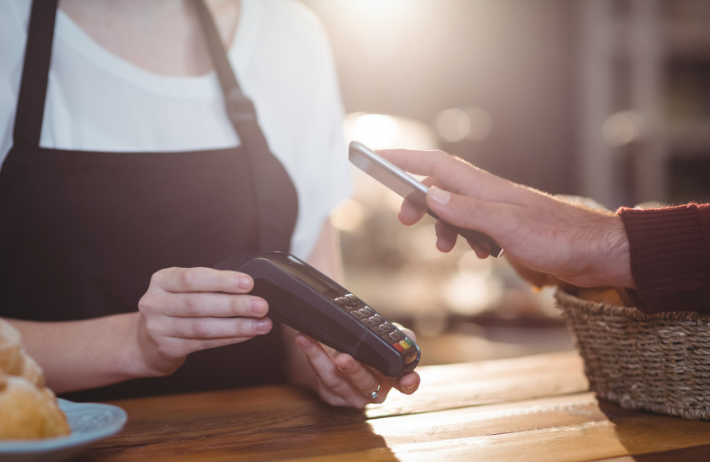
Smartphone Digital Wallets – $22b of bank revenue at risk
$22b of bank revenue at risk from smartphone digital wallets: Morgan Stanley
Smartphone digital wallets offered by Google, Apple and other technology giants will put $22 billion of revenue across the major Australian banks at risk, according to Morgan Stanley, forcing banks to lift digital investment to stay competitive.
Almost 30 per cent of banking revenue at Commonwealth Bank, or $6.7 billion, is under threat from global technology – such as smartphone digital wallets – seeking to cut banks off from their retail customers, which could also raise the cost of deposits, the report says. It finds CBA is best placed to respond given its large technology budget and the functionality of its banking app, which Morgan Stanley rates as best among the big four.
The report, the latest in the investment bank’s “Australia in Transition” series, comes a day after CBA chief executive Matt Comyn announced the bank would add a host of new features to its app to drive customers towards its own digital wallet. He said CBA had 2 million customers already using its digital wallet.
But Morgan Stanley said customers could find smartphone digital wallets provided by Google Pay, Apple Pay, Samsung Pay and PayPal more attractive, because they allow various cards and accounts from different financial firms to be linked, whereas the banks’ wallets only offer their own products.
Source: Australian Fintech ; $22b of bank revenue at risk from smartphone wallets: Morgan Stanley[
Source: This article first appeared on Australianfntech.com.au
Find out more about Indue’s Mobile Payments solutions.

Top 6 Social & Demographic Trends for 2019
Top 6 Trends for 2019
Here are 6 key social and demographic trends for 2019 from award-winning social researcher, Mark McCrindle.
Seismic shifts in Australia’s demographic trends this year will mean that Generations Y and beyond (Australians born since 1980) will become the largest proportion of the population. Our regional cities will emerge as lifestyle cities. Our cultural diversity and generational change will, in an election year, reshape the national conversation and shake-up the traditional Australian self-image.
Here are 6 key social and demographic trends for 2019 from Mark McCrindle.
1. Simplicity as a service
After a decade of digital disruption and increasing velocity of change, 2019 will mark a year of Australians seeking simplicity. The ABS states that 35% of Australian men and 42% of Australian women state that they are always or often rushed or pressed for time.
In a world of screen saturation, 24/7 expectations and always-on technologies, the year ahead will see Australians not so much turn technology off, but to turn on apps and solutions to make their life function more efficiently. People are increasingly happy to spend money to gain time. More than just an extension of the outsourcing trend, consumers will pay a premium for simplicity and seek ways to reduce the chaos and rebalance life.
2. Redefining the Australian identity
The year ahead will bring a federal election and a state election in NSW and with these, lots of policy discussions and national conversations in who we are, and as a nation, where we want to go. In addition, the republic/monarchy debate will continue along as well as our place in the world and our ongoing connection with Europe and North America amidst our increasing connection with Asia.
As the most culturally diverse nation in the developed world, the discussions about migration, population growth and the Australian identity will have a more reflective tone in a nation that rarely gets introspective.
3. New generations dominate demographic trends
From 2019, there will be more Australians born since 1980 than before 1980. This means that Generation Y (born from 1980 to 1994) and Generation Z (born from 1995 to 2009) and Generation Alpha (born since 2010) will comprise more than half of the population. Additionally, from 2019, Generations Y and Z will comprise the majority of the workforce- outnumbering Generations X and the Baby Boomers for the first time. This demographic and economic strength will see Gen Y and Z dominate as workers, consumers, new household formers and therefore as the key demographic to engage with.
4. Recessionette
The Australian economy is performing solidly with low unemployment at 5%, low interest rates and positive, though modest economic growth. However, 2019 will continue to reveal a loss in capital city house price value, high rental and utilities costs and slow wages growth. All of this will heighten the perception of Australians having wealth declines and tight household budgets.
While Australia is entering its 28th year since the last recession, and the fundamentals are a long way from a contraction, the consumer sentiment is starting to respond as though we are in a mild one. From a householder perspective, spending behaviours will be prudent, big expenses delayed and the general consumer attitude be not quite recessionary- but perhaps recessionette.
5. Rise of the lifestyle cities
While Australia’s capital cities are home to 16 million people, more than 8 million, live in regional Australia. Of the one in three Australians living outside of the capitals, most of them live in regional cities which are Australia’s lifestyle cities offering the benefits of the capitals without the congestion, infrastructure bottlenecks and affordability challenges. 2019 will see a continued focus on the regions from policy and spending initiatives to better transport connections to open up the opportunities for the regions.
Many of these regional centres were the first to get NBN and with this a booming business economy, a thriving tertiary sector and the relocation of business and government offices. The new focus on getting migrants into the regions, matching investment and services to this population growth, and the affordability premium offered by the regions will see Australians take another look at these growing lifestyle cities.
6. The power of trust
The last few years have seen Royal Commissions and other inquiries refocus and recalibrate Australians’ trust. Few sectors have been immune, from religious and political entities to corporations in the financial sector, to aged care providers to social media and tech companies, trust has been eroded. The year ahead will see a number of social and demographic trends play out. Consumers value trust, whether it be in a brand, person or entity above price, promise or experience.
Those who can gain and keep trust, through transparency, and values-based offerings will thrive in the trust-as-premium environment.
Source: This article first appeared on mccrindle.com.au/insights Author: Mark McCrindle
Indue is excited to feature Mark McCrindle as a keynote speaker at our Leadership Forum, May 29 & 30, 2019.

How consumers are redefining customer experience
How consumers are redefining CX
In their 2019 Global Consumer Insights Survey, PwC introduces the concept of “ROX” as a way for companies to measure their success on the metric of customer experience.
The following article on customer experience first appeared on www.pwc.com.au on 26 Mar 2019. Author Chris Paxton
Customer Experience (CX) Key takeaways
- Customers are embracing technology in their pursuit of online goods and services.
- Brands wanting to increase spend and frequency should focus on the changing nature of customer experience.
- Friction-less interactions that integrate with a customer’s daily life and technology are key.
Is experience really everything? Yes, according to respondents of PwC’s 10th annual Global Consumer Insights Survey (GCIS).
Canvassing more than 21,000 consumers from 27 territories, the survey found consumers the world over want good customer experience when they shop. And what’s more, with the technology they have access to, they can now demand it.
On their wish list is an experience that is curated, channel-agnostic, socially conscious and social-media-powered. For some businesses, this is a tall order, and not one that has gotten enough attention in the past. Gone are the days when a pleasant smile is enough to gain customer favour.
Consumers, with technology at their fingertips, are redefining what good customer experience means.
Living digital
Technology is infiltrating daily life at breakneck speed. Mobiles, tablets and PCs are all being used for online shopping. This year, for the first time since the study has been run, mobiles overtook all other digital devices as the preferred shopping tool. Smartphones were reported as the go-to tech for purchasing, with 24% of respondents using a phone to shop at least weekly. The trusty PC is still close, though falling in favour, at 23% of consumers, while tablets bring up the rear at 16%

Online shopping is now the norm, with only 7% of people saying they never purchase products online.
As anyone who has coached a tech-wary relative on the ease of online banking can attest, people eventually become comfortable with the online experience. Over half of those surveyed paid bills or invoices online in the last year, with similar numbers transferring money. Entertainment, such as streaming movies and TV, is also booming, with 54% watching two to three times a week or more (over half of Gen Z streams daily).
Smartphones are also increasingly being used for payment, particularly in emerging regions where mobile phone use has leapfrogged traditional landline systems. While the technology’s prevalence is different depending on the country, globally, 34% of consumers have paid for a purchase via their mobile in 2018, up 10% on the previous year.
Frictionless shopping
Newton’s first law of motion states that a body in motion will continue to remain in motion until it is acted upon by an external force, that is, until it encounters friction. Customers, it turns out, are much the same. The less friction in their purchase journey, the more they’ll shop, and the more they’ll spend. Thirty-four percent of those surveyed said they shop more frequently due to having used Amazon, suggesting the experience – and likely its ease – encourages online shopping.
Voice assistants, such as Google Home or Amazon’s Alexa, are increasingly relevant to online shoppers with their AI hearts built around predictive, frictionless interaction (even if reality is still catching up with the promise). Nine percent of the global sample said they use the technology weekly or more. As the report notes, however, “as shopping by voice continues to catch on, companies should be thinking beyond mobile to consider how voice technology in homes, cars, and elsewhere will affect customer experience”.
Anything that adds friction will not be looked upon kindly. Click-and-collect functions, already adopted by 42% of Australian retailers, are gaining favour in the US (under the acronym BOPUS, or ‘Buy Online and Pick Up in Store’), but customers need to be helped through the experience before they will trust it – and that’s where employees come in.^
The human-digital touch
While customers want to interact with brands via digital means, this doesn’t mean they want humans out of the picture entirely.
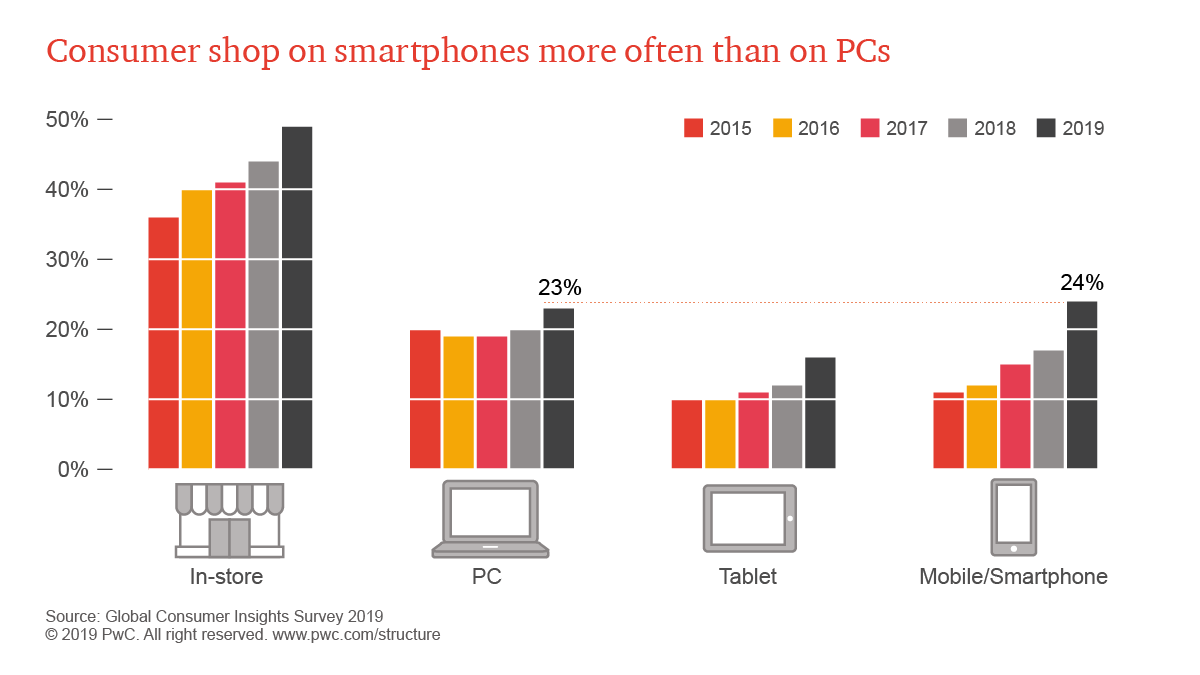 This year, smartphones have proven more popular than PCs when it comes to purchasing online, but in-store shopping is still popular. How can brands manage the mix of in-person and digital experiences?
This year, smartphones have proven more popular than PCs when it comes to purchasing online, but in-store shopping is still popular. How can brands manage the mix of in-person and digital experiences?
In PwC’s Consumer Intelligence Series report on customer experience last year we found that 59% of those surveyed believed that companies had lost touch with the human element by focusing too much on tech. One of the takeaways was that brands needed to have a good mix of technology and staff, and in particular, have tech that empowered employees to provide superior service.This finding is echoed in the current survey, particularly as regards financial services, where only 15% had purchased insurance via a digital channel, only 13% had gotten a loan and only 12% made a financial planning decision. For this industry, and others, more education is required by the customer before they feel comfortable in making a purchase. A blended experience, where in-person interaction is mixed with digital experiences throughout the journey, can prove far more fruitful in these instances.
Dreaming big
When it comes to redefining customer experience, it is also apparent that not only are consumers increasingly more willing to try online purchasing, they’re ready to increase what they do online in other ways. Almost 75% of consumers have installed as many as three health or wellness apps on their phones, and two-thirds of those surveyed are willing to access such services through nontraditional players – such as Facebook, Apple or Amazon.
 Health and wellness apps are enjoying wide adoption by consumers – particularly for weight loss and exercise.
Health and wellness apps are enjoying wide adoption by consumers – particularly for weight loss and exercise.
Health is not the only example when it comes to pushing traditional boundaries. Forty-six percent of consumers would like to have, or will consider having, an autonomous vehicle. Fifty-eight percent would consider investing in or using bitcoin or another digital currency.
It’s clear that customers are expanding their digital horizons and, as they explore, their expectations will grow with them. For brands, this means delivering a superior customer experience the entire length of the journey customers take.
Sources
This article was originally published on www.pwc.com.au. For all the insights from the Global Consumer Insights Survey, download the full report here.
^ https://www.abc.net.au/news/2017-08-30/click-and-collect-why-retailers-are-pushing-shoppers/8856504

Plastic Cards Market: Past, Present and Future Scenario
Plastic Cards Market: Past, Present and Future Scenario
The chip enabled cards segment has an estimated revenue share of almost 80% of the global plastic cards market by technology in 2018, but what does the future hold?
Article first published 18 February 2019, www.digitaldailynews.com
The chip enabled cards segment has an estimated revenue share of almost 80% of the global plastic cards market by technology in 2018, and is predicted to remain the key technology segment throughout the duration of the forecast period.
In an era filled with digital electronics, it would seem as if working with an actual plastic card would be a waste of a time. But modern technology has taken the use of plastic cards to the next level. Increased technological developments in plastic cards, such as smart cards and chip cards, are gaining traction among consumers.
Demand for Plastic Cards in the APAC Region
The APAC region is estimated to account for a 36.2% market share in terms of revenue in the global plastic cards market in 2018, and this share is expected to grow by a massive rate of 300 basis points, causing the APAC market to grab a 38.8% market share by the end of 2026. The growth in the APAC market is spearheaded by enhanced spending power and the retail penetration of luxury consumer goods in China, India, and ASEAN countries, and consumers in these countries are likely to continue to demand the highest quality plastic cards. An estimated volume of more than 14,092 Mn units and a value of over US$ 14,887.8 Mn in 2026 makes APAC the behemoth in the global plastic cards market.
Growing Demand for Secure & Reliable Payment Transactions across Various Industries
Access to the Internet has become convenient, and its usage has increased substantially due to the increasing demand for online banking & shopping and access to e-Government services. Due to the increasing adoption of e-Commerce services and cashless payments, online payments have witnessed exponential growth, globally. Along with increasing online payments, the security risks associated with them have also increased significantly. Smart cards help enhance security, reduce fraud, and enable the utilization of value-added services for end-user industries, which includes sectors such as banking, telecommunication, healthcare, transportation, and governments.
Increased Usage of Mobile Phones
In this generation, there is an increased usage of mobile phones among people. Especially in tier II and tier III places, the growth of the mobile phones sector is high. In developed regions such as North America, the mobile phones market is mature, owing to high purchasing power. Due to the increased usage of mobile phones, there will be an increased purchase of SIM cards. This helps in the growth of the plastic cards market.
Competitive Pricing from Local Players – a Major Impact on the Plastic Cards Market
One of the major challenges for the growth of the plastic cards market in Asia Pacific is the lower commodity price of manufacturing plastic cards. This has resulted in a number of companies decreasing the prices of their products and focusing more towards volume growth.
In addition, the increasing number of small and unorganized players in the market due to easy manufacturing processes, low commodity prices, and demand for branded plastic card products are also hampering the growth of the plastic cards market.
Source: Digital Daily News

Trend Report Delves into the Benefits of Mobile Wallet Payments
Trend Report Delves into the Benefits of Mobile Wallet Payments
Speedpay Pulse considers the Impact of the “Mobile Mind Shift”
For many consumers, smartphones are an integral aspect of their lives. According to Pew Research Center, 77 percent of Americans now own smartphones, up from just 35 percent from the organization’s 2011 smartphone ownership survey. As consumers have become more comfortable utilizing their smartphones for everyday tasks, many companies have simultaneously enhanced their pay by mobile wallet capabilities to cater to consumer preference. This offering includes any technology that stores payment card information, whether native to your smartphone, or via downloadable third-party payment methods.
(Source “Speedpay Pulse Trend Reports”)
Transitioning to Digital
According to the Speedpay® Pulse, a consumer billing and payments trend survey of 3,000 U.S. adults responsible for two or more household payments a month, one in four consumers currently use mobile wallet payment methods and nearly half (47.6 percent) of those people use mobile wallet offerings multiple times a week. Due to an increase in mobile wallet usage, retailers have begun offering loyalty rewards and other incentives, and based on their research, these strategies seem to be working. Of those who use mobile payment methods, 82.2 percent report using one to three methods and applications on a regular basis. The numbers were almost the same for non-payment items, as 80 percent of those who use mobile wallets also take advantage of options such as digital tickets and boarding passes.
Due to the ease and convenience of these offerings, mobile wallets are becoming the new normal, which could eventually remove the need for consumers to pack a physical wallet and smartphone each day.
 The Impact of the Mobile Mind Shift
The Impact of the Mobile Mind Shift
The growing adoption of smartphones and apps has essentially shifted consumer attitudes. Due to this change, mobile wallet payment options have become a necessity for companies, especially because this particular type of transaction is gaining traction for bill pay. Many consumers find that mobile wallet payments provide a simple, convenient payment option, unlike traditional cash and check payments. According to their most recent report, approximately 33 percent of consumers said they would consider using a mobile wallet to pay bills in the future. The top two reasons reported were speed (55 percent) and convenience (51 percent).
Weighing the Option of Adopting Mobile Wallet Payments
Many companies are still reluctant to adopt mobile wallet payments; however, in order to meet the needs of consumers, they should consider implementing mobile wallet offerings. By catering to consumer preference and interacting with them via their smartphones, companies can help ensure an easier and more seamless payments experience. Additionally, the reminders offered via mobile wallet are very beneficial and provide a convenient way to remind their customers to pay. Many mobile wallets have the capability to send monthly statements and notifications directly to a customer’s smartphone, which offers an additional communications channel. Lastly, if companies consider adopting mobile wallets, they will be able to increase self-service and digital engagement among customers, which can lead to a decrease in paper usage and overall operational costs.
Mobile wallet payments will continue to gain popularity in the foreseeable future. Whether customers are paying their bill with a physical debit/credit card or via mobile wallet, it’s recommended that companies constantly communicate with their customers to provide them with a convenient and seamless payments experience.
Article first published 19 February 2019, www.paymentsjournal.com Author Alexis Blackstead
Source: www.paymentsjournal.com Read full article here. To learn more about consumers’ mobile wallet payment preferences, download the Speedpay Pulse Trend Report here.

24/7 Cyber Security Monitoring – Partnering with Deloitte
24×7 Deloitte Cyber Security Monitoring
As part of our cyber security program, Indue has implemented round-the-clock monitoring to identify any attempted malicious activity.
The proliferation of technology means that Cyber security threats are now commonplace and growing in sophistication, requiring proactive management. As part of our proactive cyber security program, we are pleased to advise that Indue has implemented 24/7 cyber security monitoring of events to identify any attempted malicious activity against our network.
Indue has partnered with Deloitte, using their Cyber Intelligence Centre for 24/7 cyber security monitoring to identify and stop brute force attacks or hackers in the system.
As a worldwide, experienced leader in cyber strategy consulting and cyber intelligence, Deloitte provides technological innovation and broad industry expertise. Indue is confident that as new technologies emerge and connectivity increases, Deloitte Cyber Risk is uniquely positioned to help our us navigate this complex landscape.
This has been a major project for the business, and one that we are immensely proud of, as we commit to delivering safe payment solutions.

The NPP turns 1 this week (New Payments Platform)
New Payment Platform turns 1 this week
This week marks one year from the launch of the New Payments Platform (NPP) in Australia, and its first overlay service, Osko, which delivered the ability for payments to be made in real time.
With 75 banks now offering NPP, more than 2 million PayIDs registered and month-on-month growth around 20%1, it’s clear financial institutions are recognising the benefits this platform offers their customers. This week, the NPP turns 1!
“Indue is one of the 13 founding members of the NPP initiative, and we’re proud to see the NPP adopted among our diverse client base, including a mix of smaller banks supporting retail customers. It’s been an incredible year of innovation in payments and we would like to congratulate all involved in reaching this milestone anniversary.” (Indue CEO Derek Weatherley)
And our customers’ customers are enjoying the benefits. Just like how this Queensland Country Credit Union customer realised his dreams of owning a boat in an (almost) instant thanks to Real-time payments.
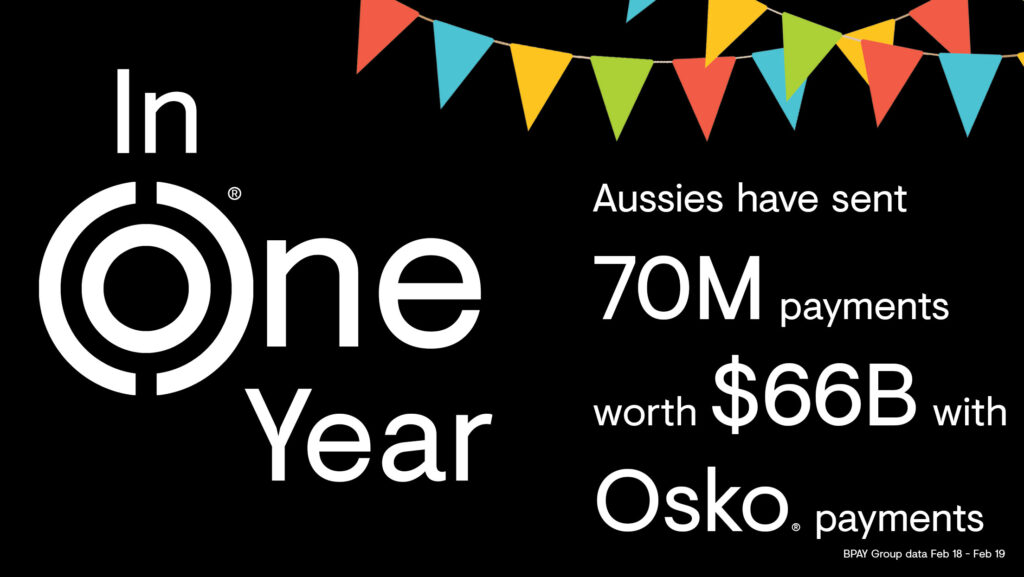
How Australians are using real-time payments 2
Osko by BPAY is the NPP’s first overlay service being used by consumers, businesses and fintechs. Since launching, Australians are enjoying the benefits of real-time payments and paying family and friends in under a minute, 24/7, even on weekends and public holidays.
“People transfer money at all times of the day – after dinner, on the weekends, at a footy match or cinema or even when buying something on Gumtree. Increasingly, they are expecting to access their money immediately. Most people will notice they have made an Osko payment when they get their payment receipt in online banking.” (Mark Williams, Chief Strategy Officer of BPAY Group.)
BPAY reports that Osko payments are not just limited to consumer to consumer transactions, with 30% of payments are to, or from, businesses and between businesses.
Mark adds: “Consumer expectations about how they pay and get paid are changing and we have been innovating to offer solutions that meet their needs. Osko Requests is in the pipeline, which will enable you to request a payment from within your online banking – making it much easier for someone to pay you back. We are also working to allow businesses to use Osko Requests and include documents such as invoices. So the NPP turns 1, is it too late to join the New Payments Platform?
The short answer is, of course, it’s not too late…yet. But savvy players in the industry recognise the importance of staying relevant in the face of digital disruption, and keeping the end-customer top of mind. If you are not providing the benefits of a simpler, faster and safe payment system to your customers, it’s likely a competitor or substitute will.
Find out More
Find out more about how Indue can help you participate in our new Real-time payments world.
1 Source Reserve Bank of Australia https://www.rba.gov.au/statistics/tables/
2 Source (OSKO by BPAY media release 13/2/19)
Related articles

How fintechs are responding to the Royal Commission
How fintechs are responding to the Royal Commission
The 76 recommendations of Hayne’s final report have been made public, but do Australia’s fintechs think it will change banking?
Article first published 5 February 2019, Finder.com.au. Author Elizabeth Barry
The final report of The Royal Commission into the Banking, Superannuation and Financial Services Industry has been handed down by Kenneth Hayne AC QC, and all firms in Australia’s financial industry, which includes fintechs, are taking it in.
The report made made 76 recommendations in total, including that borrowers should pay mortgage broker fees and that consumer protection laws should be extended to small business loans of under $5 million. The recommendations were focused on Australia’s financial regulators and financial institutions, but depending on the changes that are made, the recommendations would have an impact on the entire financial services industry.
CEO and founder of Australian neobank Xinja Eric Wilson said the reality is that we have “reached a new low”.
“But the report is a line in the sand and marks a real opportunity to shake up the industry and redesign it in the interests of customers,” said Wilson.
Wilson believes the rise of fintechs like Xinja and open banking, due to begin in Australia later this year, will offer a different model for consumers.
“Competition is the silver bullet. The emergence of neobanks like Xinja, which offer a different model, means that people poorly treated by their banks will be able to shop around. It will also become much easier to switch, with the rollout of open banking.”
The introduction in Australia later this year of open banking, which will hand consumers their data allowing them to aggregate information and shift banks or financial services providers more easily, will go a long way to easing the legwork around switching.
Brett King, advisor to the Xinja board and management and former banking adviser to the Obama White House said: “The Royal Commission identified a range of problems and inadequacies in the current system, addressing them requires more than just putting a new face on old banks.
“The emergence of challenger banks, like Xinja, enable us to design, from the ground up ethical, modern and inclusive financial services, without the baggage of the traditional players.”
“Fintech startups and investors with rent seeking, ethically questionable business models, based on selling private individual data, having high or hidden fees, exploiting customer ignorance or financial desperation, should be on notice and will face the risk of criminal charges. Change is coming and it is not just going to impact the big banks.
“Fintech needs to build around ethical, sustainable business models. In a sector devoid of trust, fintech startups can differentiate themselves and shine a new light of openness and transparency.”[/vc_column_text][/vc_column_inner][/vc_row_inner][vc_column_text el_class=”ind-textBox”]Founder and CEO of Roll-it-Super, Mark MacLeod, said the Royal Commission evidenced a financial services sector “riddled with conflicts of interest and greed” and that any fintechs with similar notions should take notice.
“Fintech startups and investors with rent seeking, ethically questionable business models, based on selling private individual data, having high or hidden fees, exploiting customer ignorance or financial desperation, should be on notice and will face the risk of criminal charges. Change is coming and it is not just going to impact the big banks.
“Fintech needs to build around ethical, sustainable business models. In a sector devoid of trust, fintech startups can differentiate themselves and shine a new light of openness and transparency.”
Source: www.finder.com.au Read full article here.


